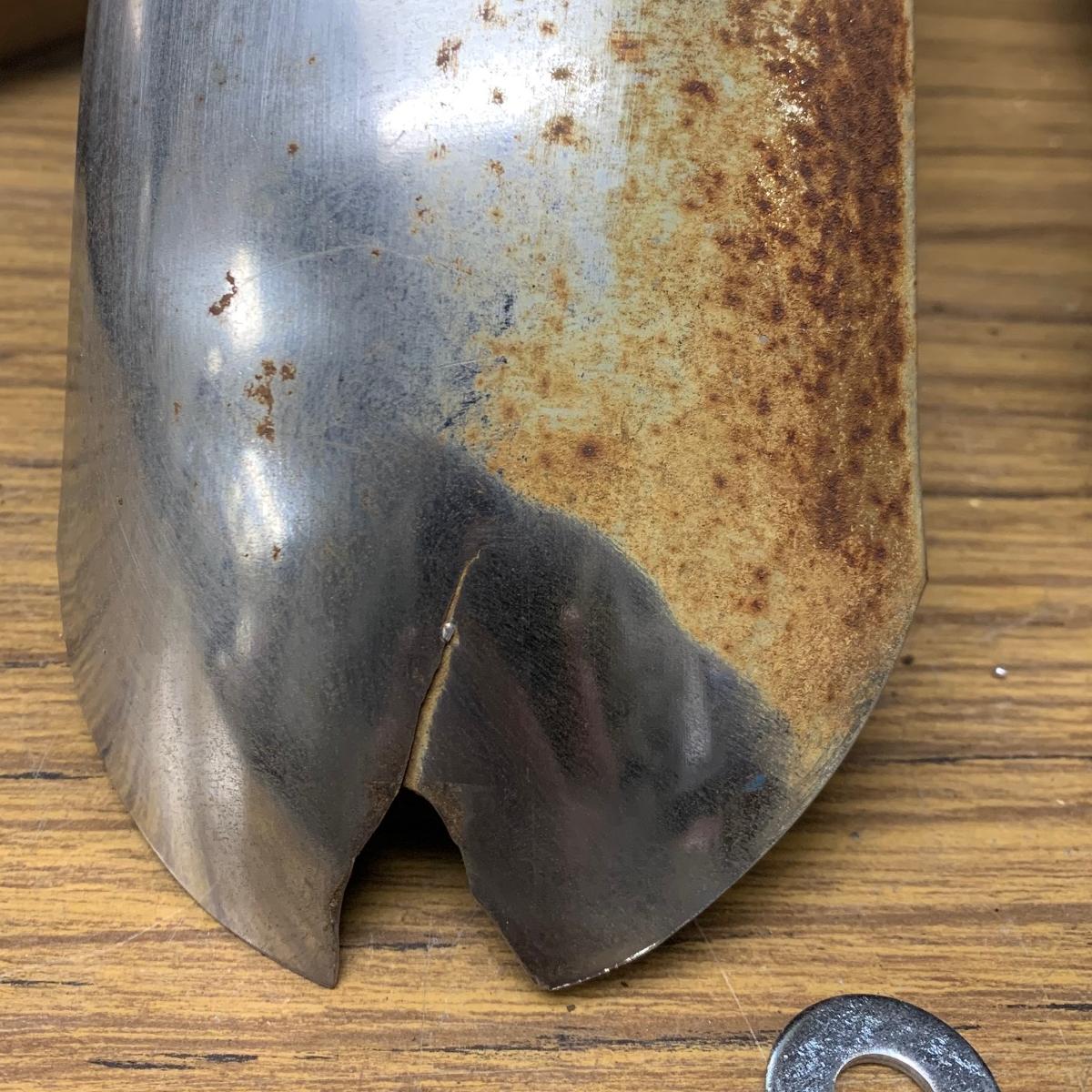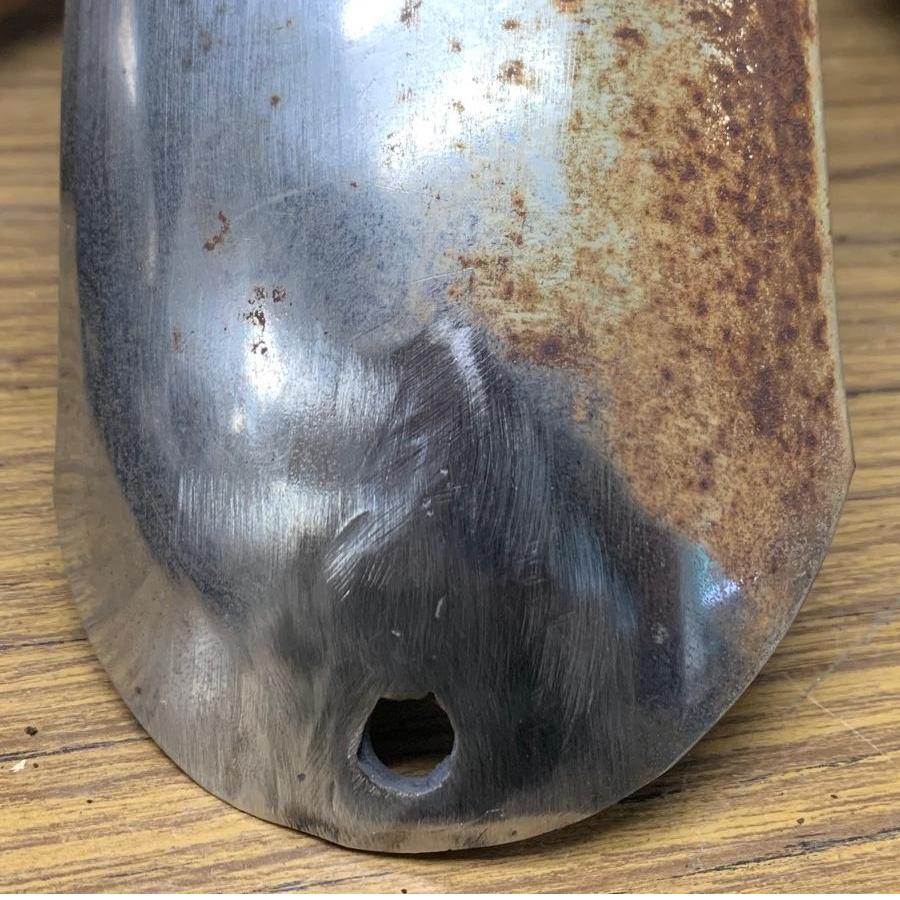I buy and collect MTD minibikes. 11/03/20. Email: cfh@provide.net
Overall MTD History and Info.
Skip to repair info.
-
MTD (Modern Tool & Die) of Cleveland Ohio started business in 1932,
and are still in business today. Early on they concentrated in automobile stamping
(and during WW2 made mess kits for the Army). By 1952 they started making
pedal bikes and kiddie cars, and then garden equipment. In 1958 MTD started making
gas powered lawn mowers and garden tractors. In 1966 MTD purchased a plastic company
(which would make the plastic gas tanks for the MTD minibikes.)
MTD made a lot of small engine products during the 1970s to present.
Many know MTD as "Yardman" and "Troy Built" lawnmowers, trimmers, lawn tractors and snowblowers.
In 1981 MTD bought Cub Cadet from International Harvester.
The MTD "Trail Bike" models 361-100 (2.5hp), 361-150 (3hp), and 363 and 364.
Probably MTD's most conventional minibike design.
The 361-100 is their weakest design with no supension and a 2.5 hp Tecumseh motor. Note
in different catalogs the model number changed (see below).
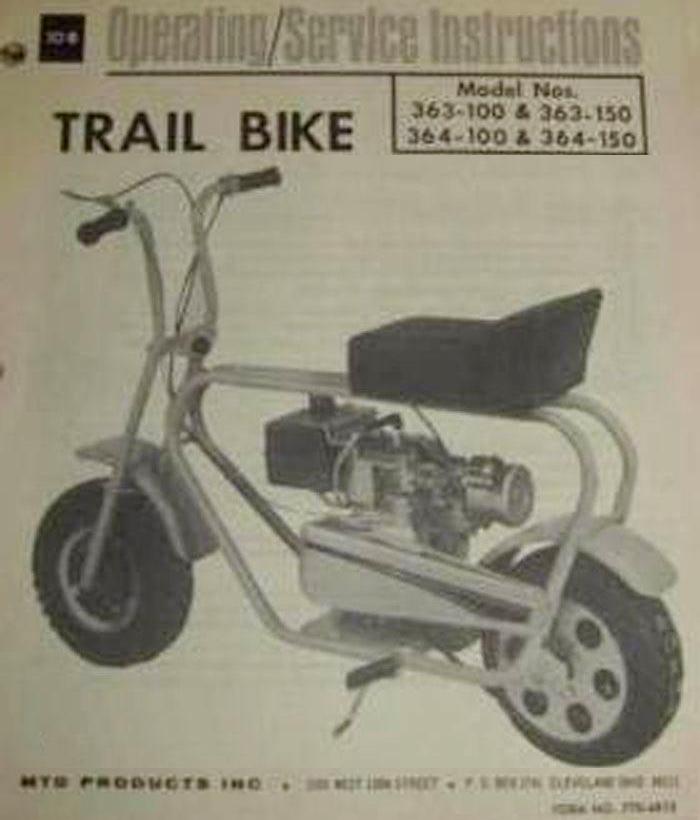
From the 1971 catalog, the model numbers seemed to have changed from 363 to 361.
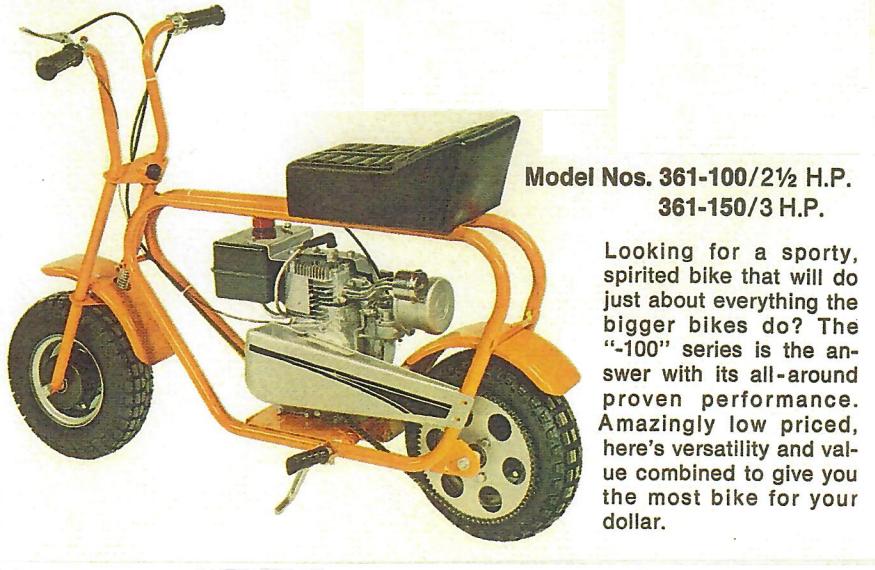
-
MTD likes to do their designs in-house. Therefore
their minibikes were a bit different. Obviously they took leads from other
makers (Fox, Rupp, etc), but some MTD ideas were definitely their own.
You can tell this by just seeing their mini bikes, they are different looking!
The MTD "Trail Bike" or "Trail Flite" model 540-100 or 361-200 (3.5hp) and 361-250 (4hp).
I believe that MTD used this "trail flite" monkier for a lot of their bikes, as they evolved.
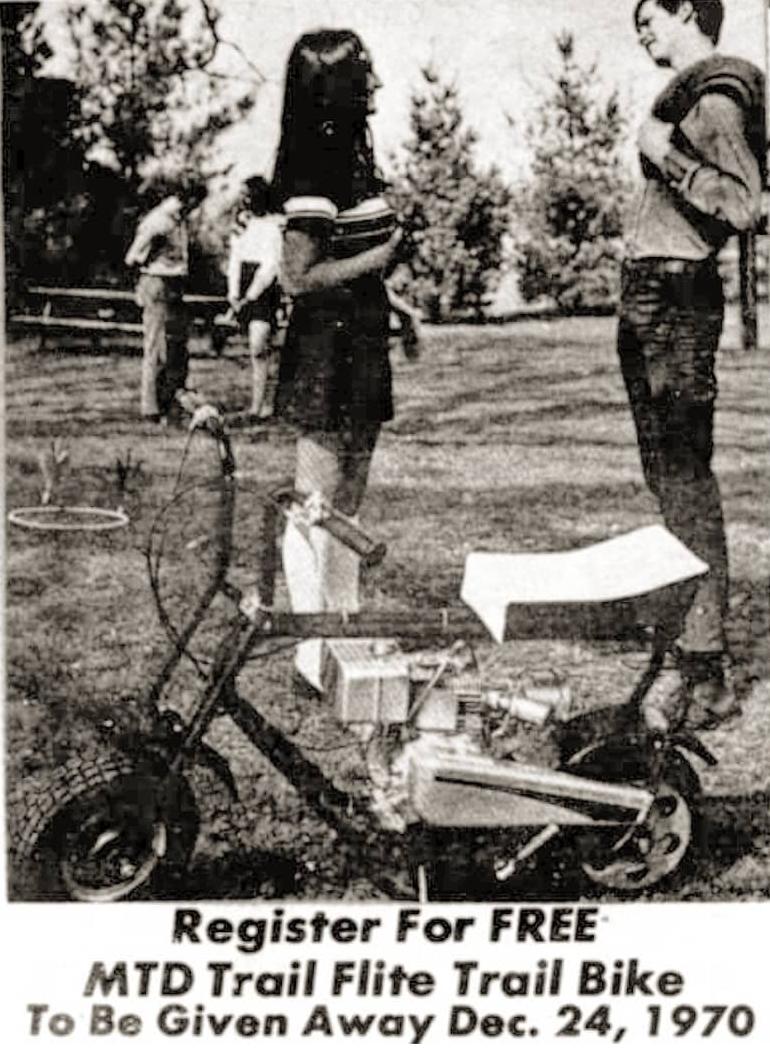
-
It is not entirely clear when MTD started mini bike production. But my guess
is 1970. Their first model appears to be their "trail bike" model 363 and 364 (or models 361-1xx).
Looks like that came out about 1970. But the more popular MTD model seemed to
come out around 1971. I say this because bikes after the initial "trail bike"
or "trail flite" MTD minibikes had two common feature... the
20 degree angled Tecumseh motor and an assymetrical torque converter.
Briggs and Stratton motors never seemed to be used on MTD bikes,
which is important to note, because Briggs stopped supplying
minibike motors in 1969 (Tecumseh probably thanked Briggs for that.) And
torque converters came about in 1970. Hence it's a pretty good indicator that
MTD didn't make mini bikes before 1970.
And to add to that, all MTD's I've seen have a float bowl carb with an
angled intake manifold, which is a 1971 feature (during 1970, the first year
of the angled Tecumseh engine mount for other makers, everyone used a diaphram style carb
and a standard intake manifold.)
A really bad picture of a 1970 MTD catalog.
It shows the three models MTD offered. From what I can tell from this
incredibly crappy photo, is the model 540-520 (left) had full suspension
and a 4hp Tecumseh motor. The 540-250 (middle) had a 3.5hp Tecumseh motor and
just front suspension. And the model 540-100 (right) had a 2.5hp Tecumseh motor
and no suspension

-
In 1971 the higher end MTD models came to be. Again the model numbers are confusing.
But the 1971 MTD catalog shows the
new full suspension models 361-600 (no lights) and 361-650 (lights) to be
their best offering. These have removable handlebars with a big black wing
nut on the sides of the triple tree to accommmodate their easy removable. (This is
important because in 1972 they offered motocross style handlebars too.)
The 4hp Tecumseh was silver and 20 degree mounted, and used an assymetrical
torque converter. Front leading link suspension and a normal rear swingarm/suspension.
The "interweb" often shows the leading link model as available in the 1960s - this is
simply not true. The release date for the leading link MTD models was 1971 at the earliest.
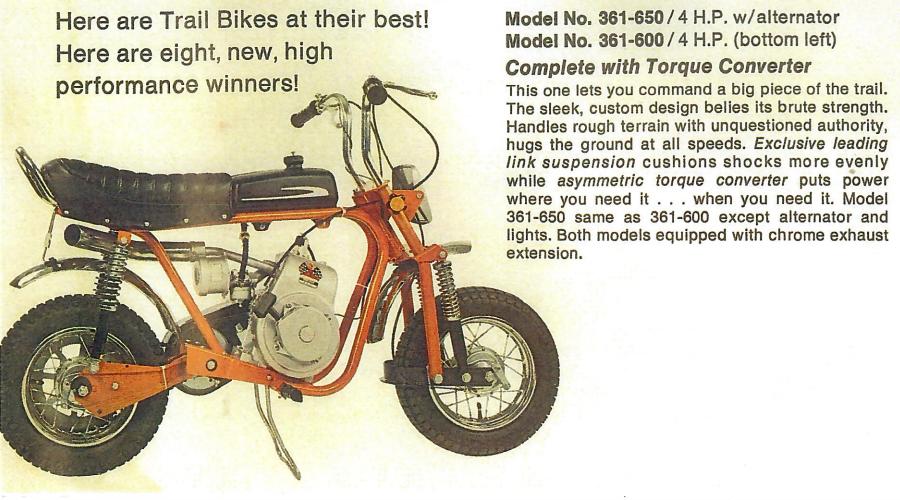
MTD (also marketed as Columbia) made basically three different models of mini bikes. Their catalogs indicate six (or more) models, but really it boils down to three models. The bikes with the leading link front suspension, the ones with (kind of) suspension, and the one with no suspension! I can hear your question already... "what is a leading link front suspension???" We'll get to that in a minute. Note nearly all the models with suspension had the nickname "Trail Flite", so really that doesn't help differentiate the models.
MTD page from the Western Auto catalog. Judging from the rounded engine blower housings
and the removable handlebars,
this is probably from 1971. Also notice the silver engine color on the $264 model.
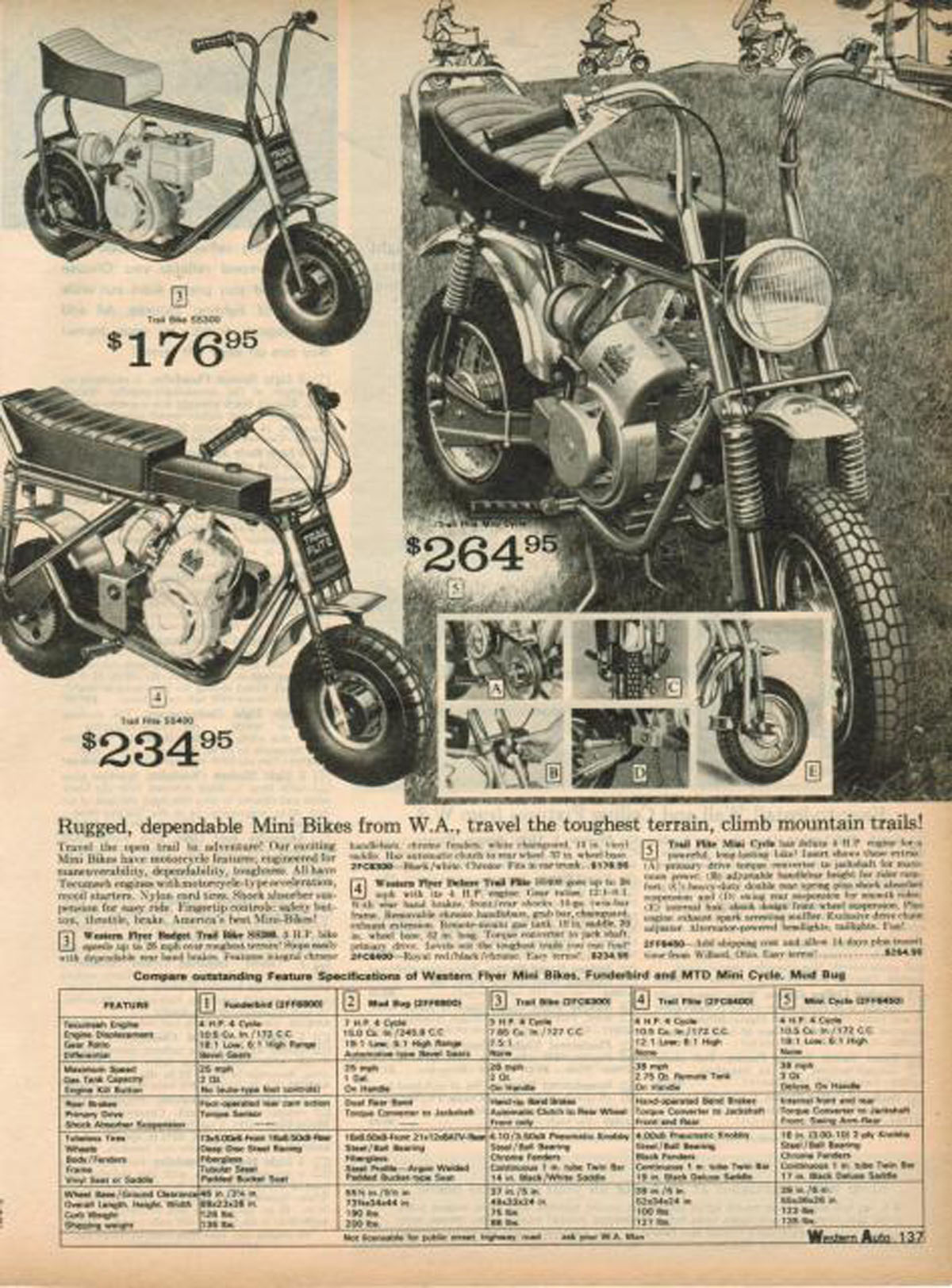
The MTD/Columbia mini bikes models. My guess is this ad is from 1975. Notice the
squared black engine blower housings on the 603 and 703 models. Also notice the different
gas tank styles.
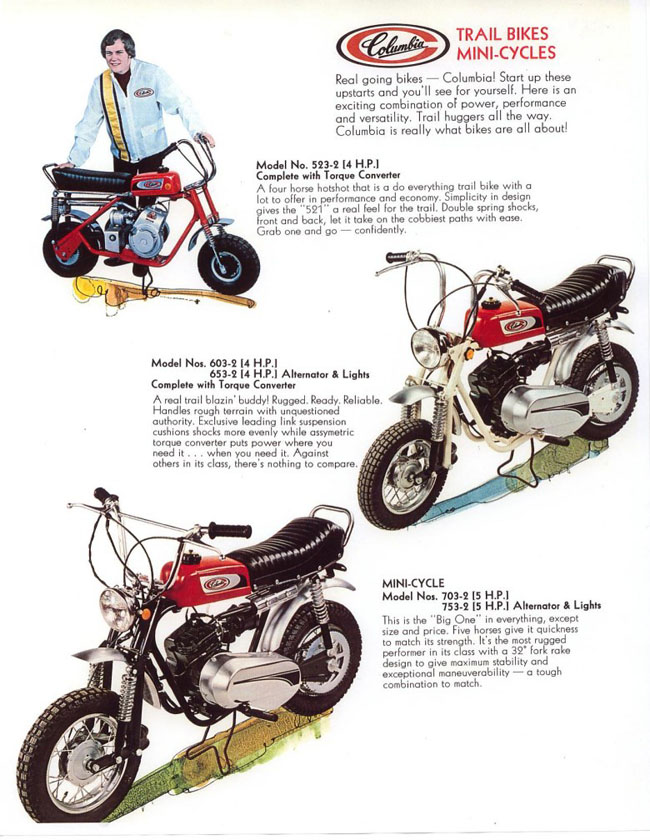
The MTD 'Trail Bike' minibike.
This model was entry level with a 2.5hp Tecumseh motor and no suspension. There's not much to it, the basic of basic minibikes. It used a motor-mounted gas tank, unlike all the other models that had a separate discrete black plastic gas tank. MTD used several different model number for this bike including 540-100, 363-100, 361-100 (2.5hp) and 361-150 (3hp).
A lot of people call these MTD models "ugly". I guess it sort of is, but it does have its charm. Comes with 6" wheels and a separate black plastic gas tank. The front suspension is really next to nothing (as far as front suspensions go.) But it does have a nice 20 degree angled gray Tecumseh HS40 or H35 engine. Also uses a V-plex symmetrical torque converter (like a Comet series 20) with a jackshaft and a nifty "thin" TC cover. The Tecumseh has an angled intake manifold to accomodate the float bowl carb. The rear brake is an interesting item. Imagine a drum brake housing, but instead of an internal drum brake, it uses an external band brake (like a clutch brake.) It works well but not a common thing, as far as mini bikes go. The exhaust is a nice Taylor muffler (a standard mini bike muffler), but with an added two foot chrome extension (which bolts over the edge of the Taylor), to give it a nice custom look! Also these models uses a center stand style kick-stand, which again is a very nice touch.
Note after 1970 MTD changed from the V-plex torque converter to a Fairbank Morse torque converter. This demanded a changed in the torque converter cover to the thicker (deeper) version (4.5" deep, versus 3" deep.) The thinner cover design doesn't fit anything but the V-plex torque converter because of the flat shape of the driver. The thin cover can be used on the Fairbank Morse torque converter, but the mounting brackets must be modified.
The 1971 MTD "ugly" models
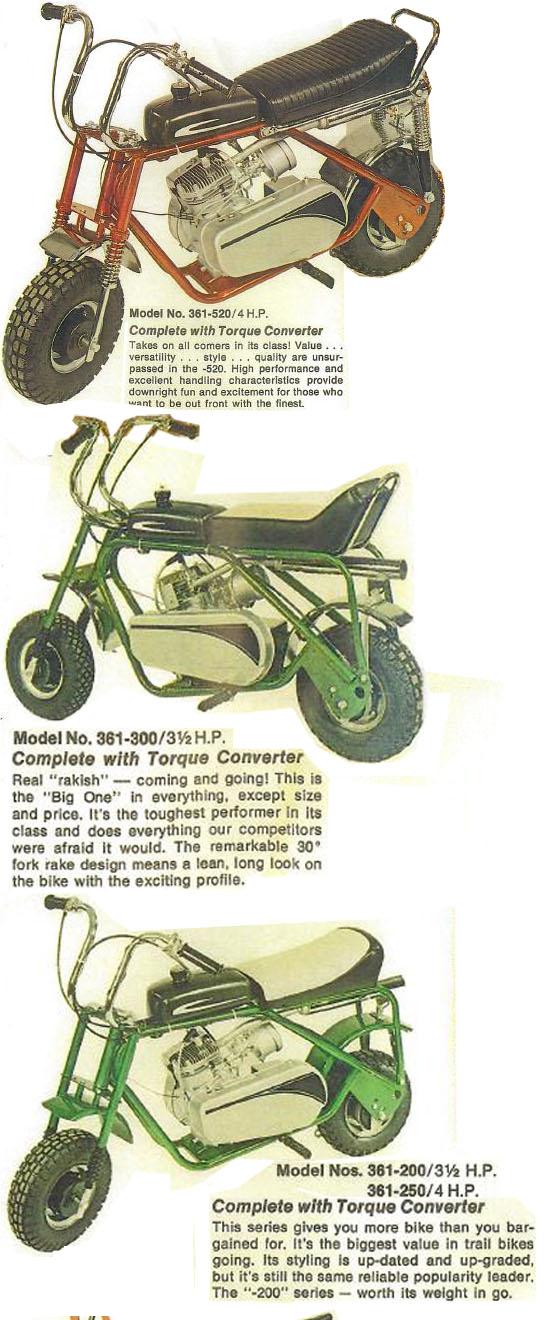
-
The 1971 six inch wheel "ugly" models from the catalog look like this:
- model 361-200: small front suspension, 3.50-6 tires, symmetrical torque converter/jackshaft, gray H35 tecumseh 20 degree mount, remote gas tank, 23 degree rake, painted fenders.
- model 361-250: small front suspension, 3.50-6 tires, symmetrical torque converter/jackshaft, gray HS40 tecumseh 20 degree mount, remote gas tank, 23 degree rake, painted fenders.
- model 361-300: small front suspension, 3.50-6 front tire/4.00-6 rear tire, symmetrical torque converter/jackshaft, gray H35 tecumseh 20 degree mount, remote gas tank, kickup seat/chrome seat tail, 30 degree rake, chrome fenders. At some point in time, this model got rear seat suspension.
- model 361-520: springer front suspension, seat rear suspension, 4.00-6 f/r tires, symmetrical torque converter/jackshaft, gray HS40 tecumseh 20 degree mount, remote gas tank, chrome seat tail, 30 degree rake, chrome fenders.
Note at some point MTD changed the prefix on their models from 361 to 368. I don't know when/why this happened, but it did.
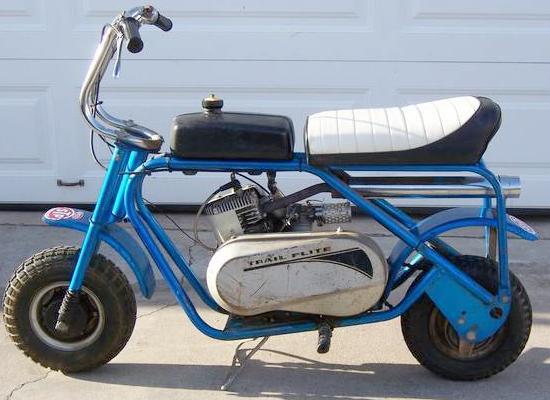
-
The lower "ugly" MTD mini bike models have painted fenders. The mid and upper "ugly" models
have chrome fenders and a better seat. All of these "ugly" models have the nice Taylor/chrome
extension exhaust.
A step up on the MTD line, model 361-300 (3.5hp).
Note rear suspension (kind of) and a rear chrome hold bar and chrome fenders. Also this
bike has the "thick" clutch cover and a nicer seat.
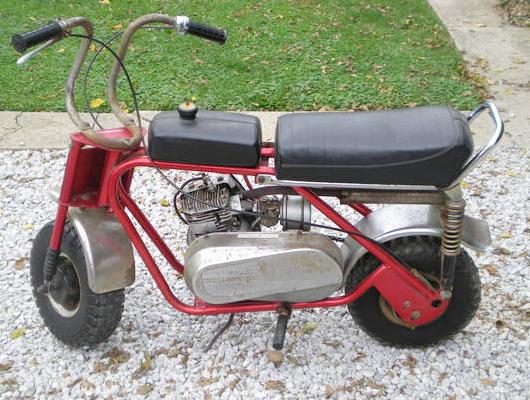
-
The upper side of the MTD "ugly" models is the 361-520 (as identified in 1971) or SS-400.
This had added rear suspension. Well kind of
rear suspension. There's no swing arm, it's just the seat mounted to the hard tail
rear end via two shocks. The front seat mount swivels to achieve this.
Also the front suspension has larger external chrome springs. It looks much
more impressive and has better load/travel.
This is a refined generation of the other lesser "ugly" MTD models. Often sold as the
Western Flyer SS400 (and other names).
A refined MTD "ugly" model 361-520 (1971 catalog model) with 4hp Tecumseh, and sold as the Wester Flyer SS400,
with springer front suspension. Has the thicker (deeper) clutch cover.
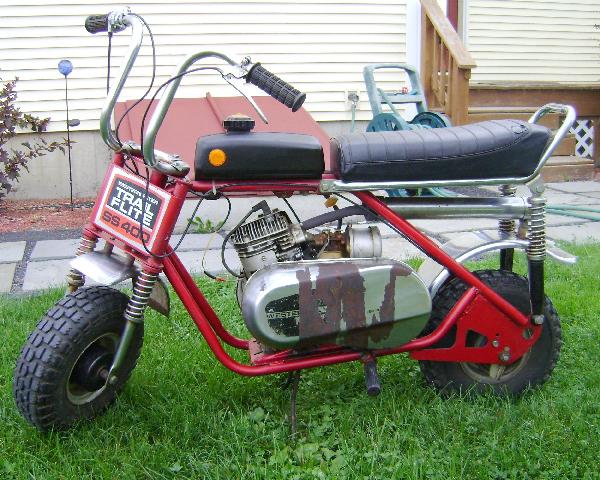
-
A couple interesting things did happen to the "ugly" line over time. First is the gas tank.
Originally it's very squared off and rectangled looking. Later models (circa 1972?) had more
rounded edges on the black plastic gas tank (like the leading link models.) Also the seat became
more rounded too on later models. And the metal clutch cover became deeper on later
models (though the basic look was the same.)
MTD "ugly" model torque convert set up. It's a series20 symmetrical style (inward moving driven.)
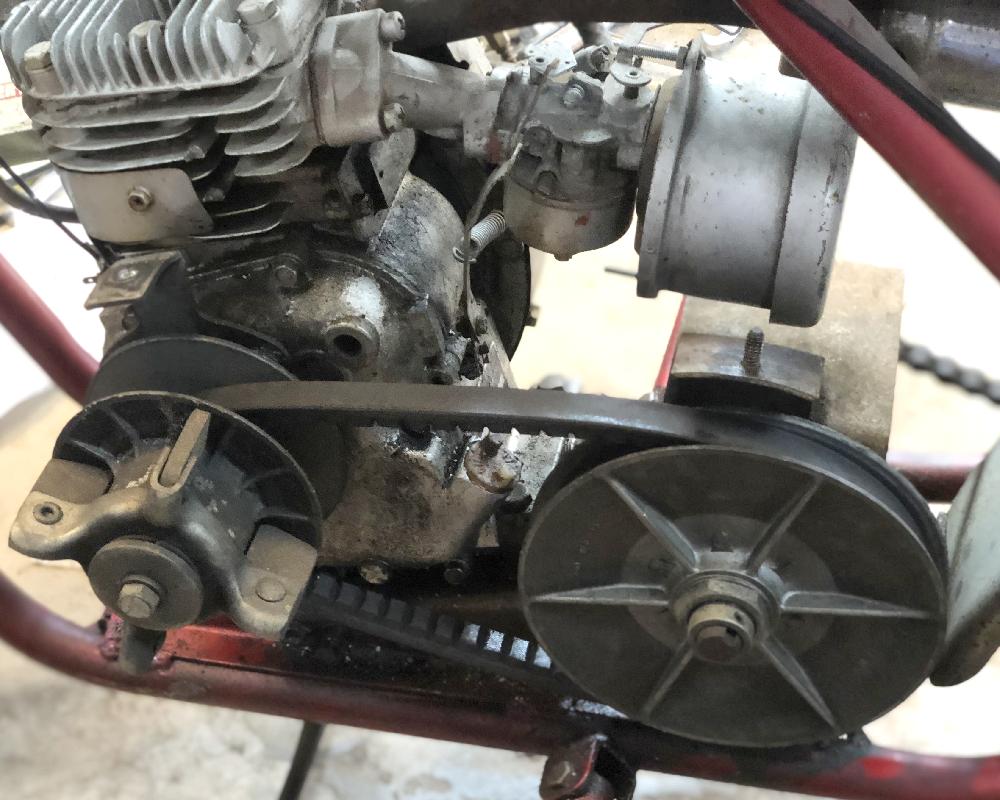
Leading Link MTD minibike models 6xx and 7xx.
-
The other model of MTD minibikes is the full suspension model, which
utilizes a leading link front suspension. The leading link front end is
rather funky looking, but man does it work well! Frankly better than
a telescopic style front end. It is often known as the "missing link"
front end because of this.
The MTD leading link ("Earls") suspension on a model 753.
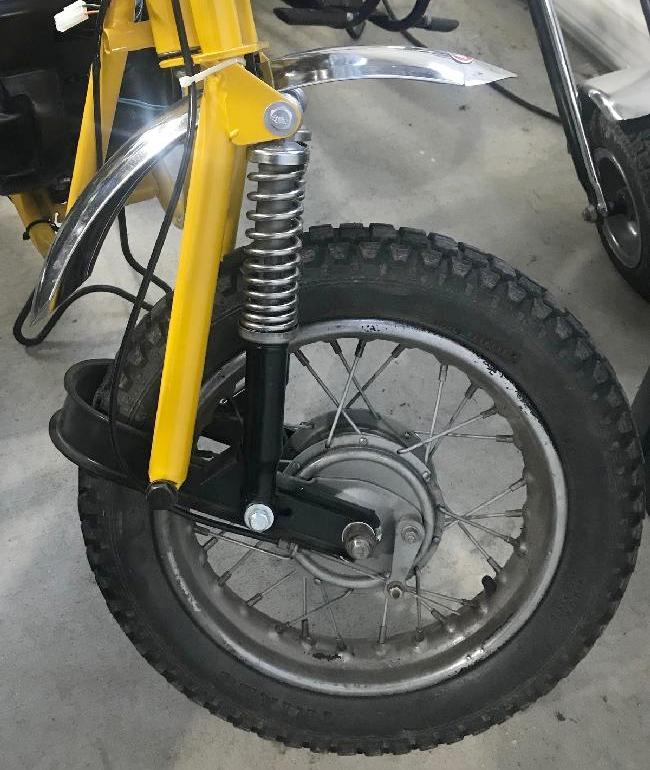
-
The models that used this great front suspension are the 603/653 and 703/753 and 361-650/361-600
models. The difference between these similar model numbers are
just lights or not. But to be frank, I'm not sure MTD/Columbia actually sold many of these models
without lights! It sure seems like every one of these I've seen has (or had)
lights (and a Tecumseh motor with a lighting coil, to power the lights.)
But the models without lights used a nifty numberplate instead of a headlight.
The lights were Peterson made with dual toggle switches (off/on and high/low).
They will be stamped on the back as AP4600 or PM711.
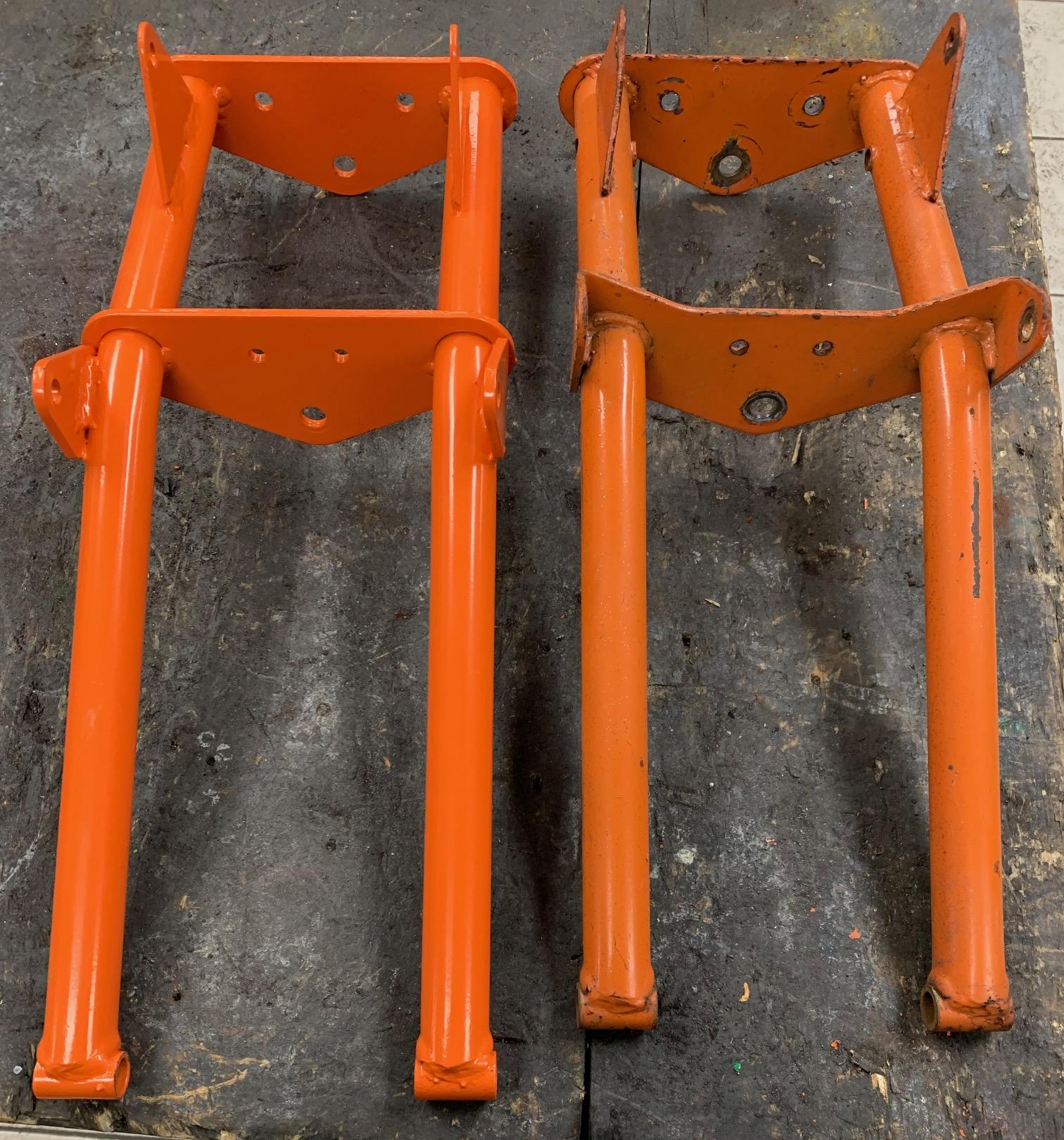
Another change that happened was an increase in length to the front fork
U-bracket. This was probably done to allow the usage of a 12" front wheel
on the leading link front suspension models. But interestingly, even with
the short U-bracket, a 12" front wheel fits fine. Bottom U-bracket is the
newer, longer style in the picture below.
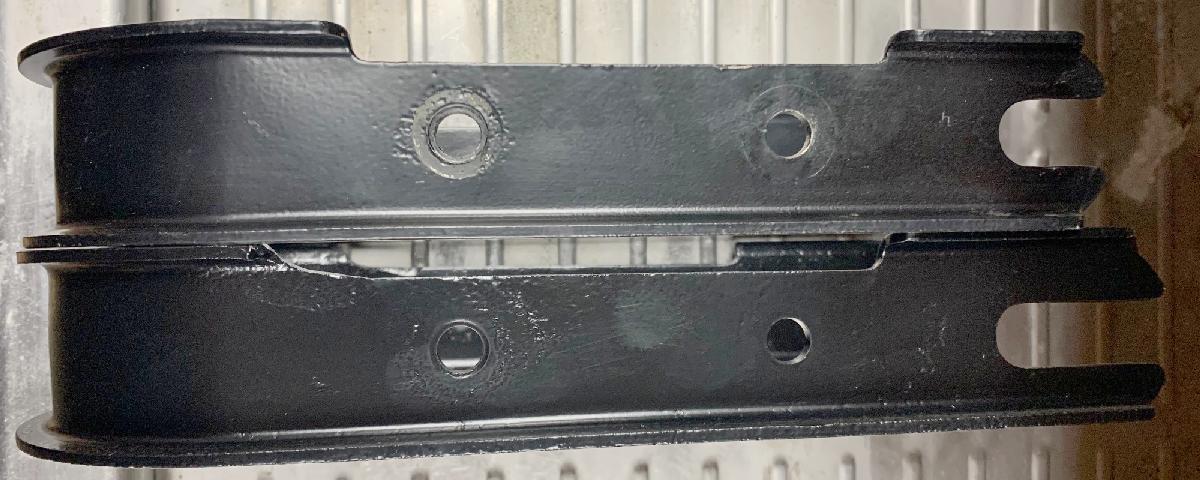
-
Also most of the time the torque converter cover
said "Trail Flite", which is confusing since a lot of the "ugly" models are
called "trail fligt" too. MTD didn't make their model name/number systems
very consistent.
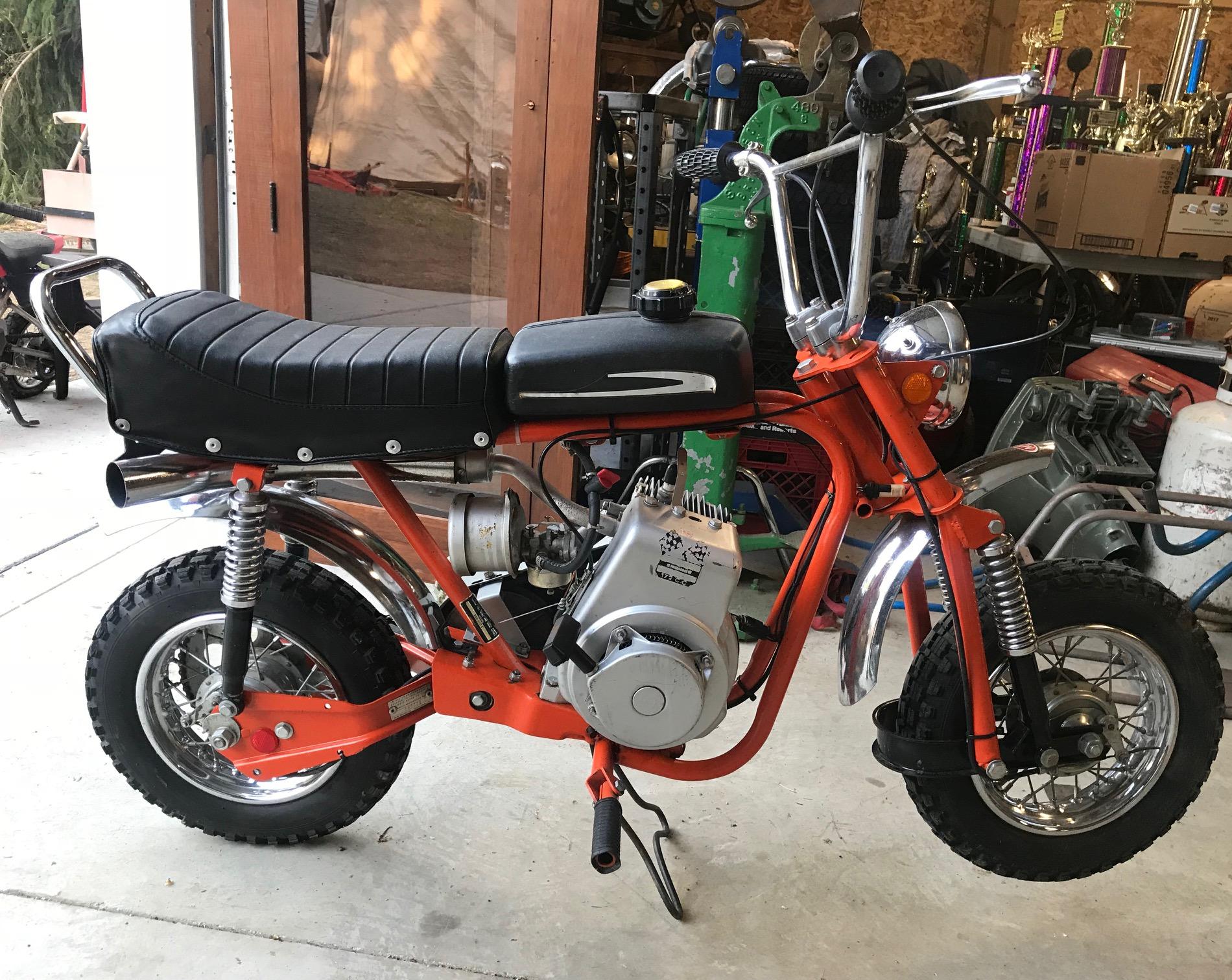
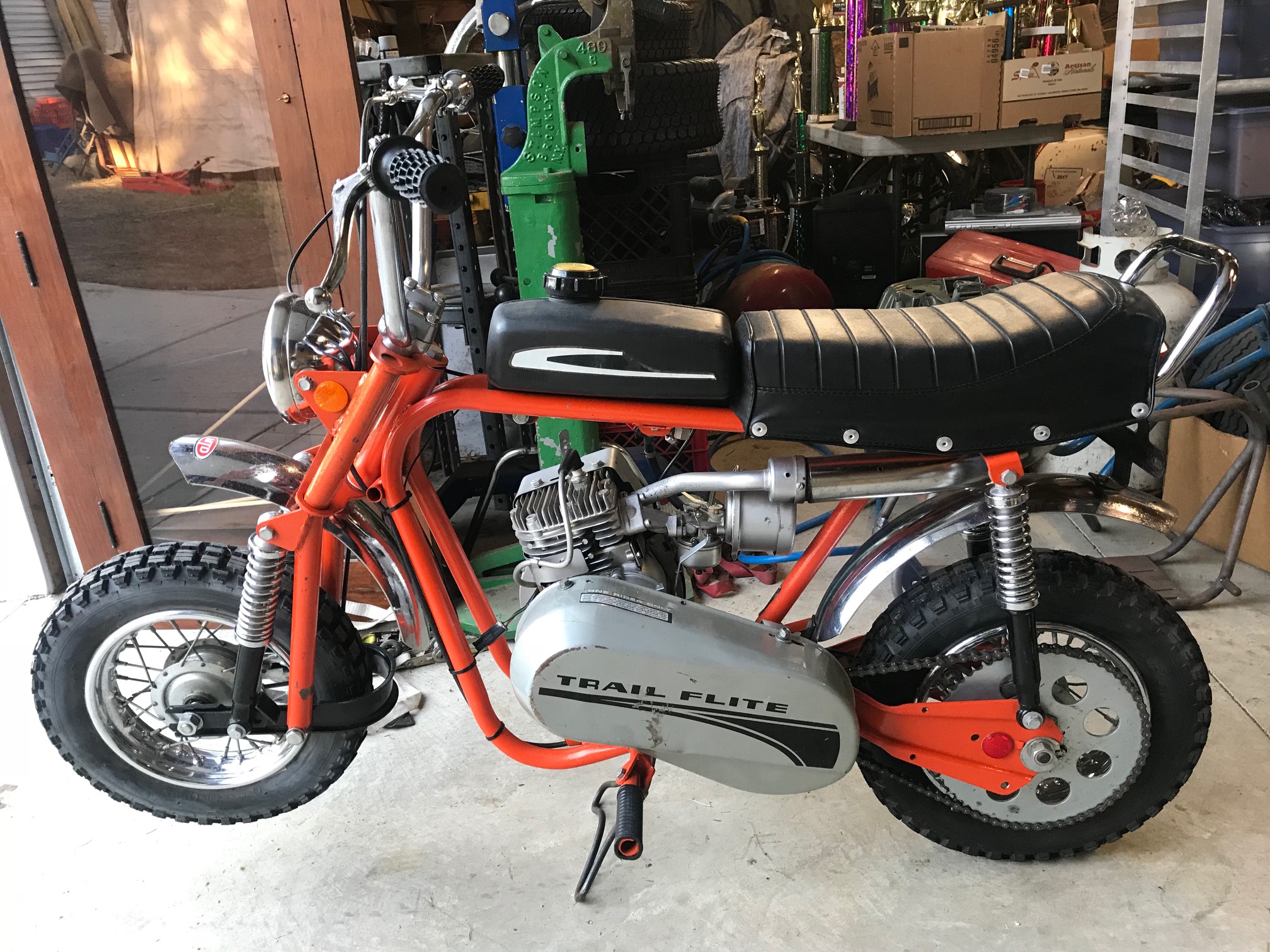
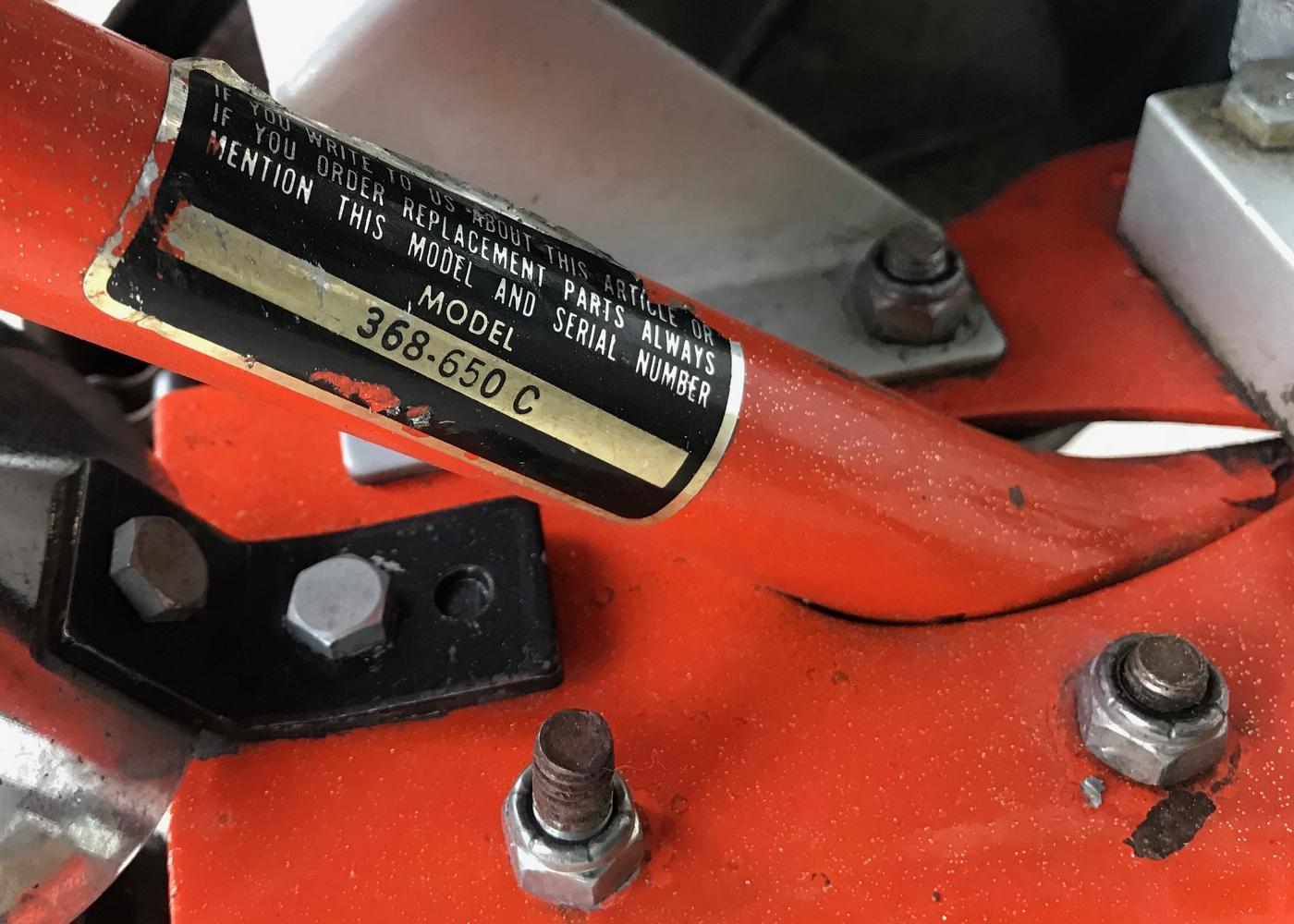
There's a bunch of other nice features about the 6xx and 7xx bikes that make them quite nice riding mini bikes. The wheels are spoked 10" diameter with trial tires. They have full rear suspension with a swing arm and a jackshaft. And again the leading link full front suspension. They also use an assymetrical torque converter (made by Fairbank Morse, but is the equivalent to a Comet 30 series.) This is an outward moving assymetrical driven system (unlike the inward symmetrial driven used on the "ugly" models.) Also like the lower model, a center stand kick-stand is used along with a great custom chrome exhaust. The Tecumseh engine is 20 degree mounted with a slanted intake manifold and float bowl carb. The seat is a snap variety (actually riveted), like Rupp was doing too. The torque converter cover was the same style as the later entry level "ugly" models (the deep version). The plastic gas tank was the same too as the later "ugly" models with rounded edges (though the Columbia models seemed to have a different red gas tank, though I have never actually seen that tank used on any MTD mini bike).
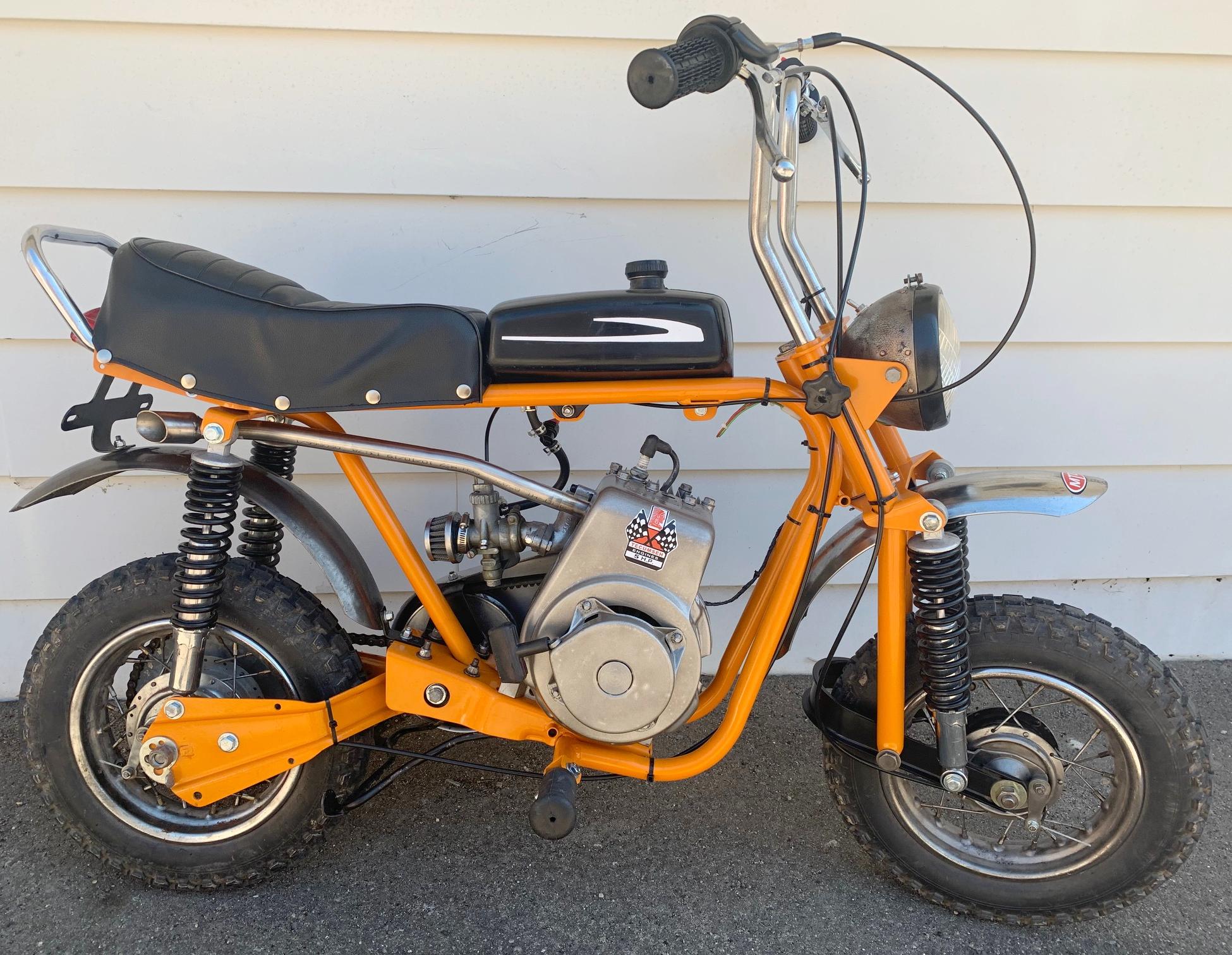
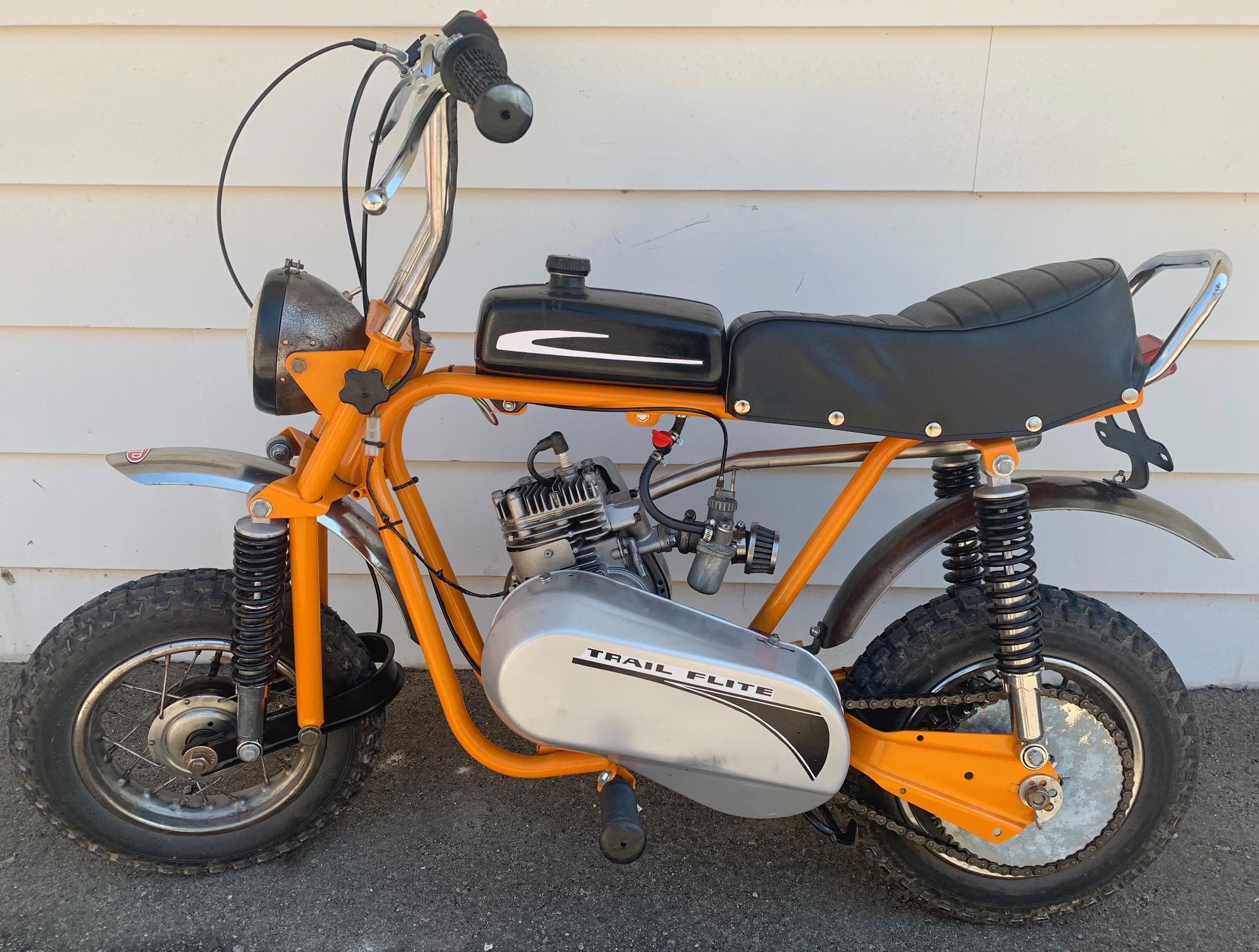
So what is the difference between a 6xx and 7xx MTD bikes? It's not a huge difference, but basically the handle bars and motor, and later, the front wheel. The 6xx and 361-6x0 series uses non-adjustable chrome handle bars with a more street bend, with a knob on each side of the triple tree (which allows easy handlebar removal.) It also had a Tecumseh HS40 four horsepower engine. The 7xx models use motorcross style handlebars (with a cross member) which are fully adjustable. And the 1972 and later 7xx models had a Tecumseh HS50 five horsepower engine. That's the main difference between the two models. But when the leading link model was introduced about 1971, all flavors had 10" wheels and a silver 4hp Tecumseh HS40 engine. In 1972 when Tecumseh introduced the HS50 engine (5hp), this became an option for these MTD models, and these had a 12" front wheel and were usually yellow bikes. Also the motor color (usually) changed from silver to black with the move from 4hp to 5hp.
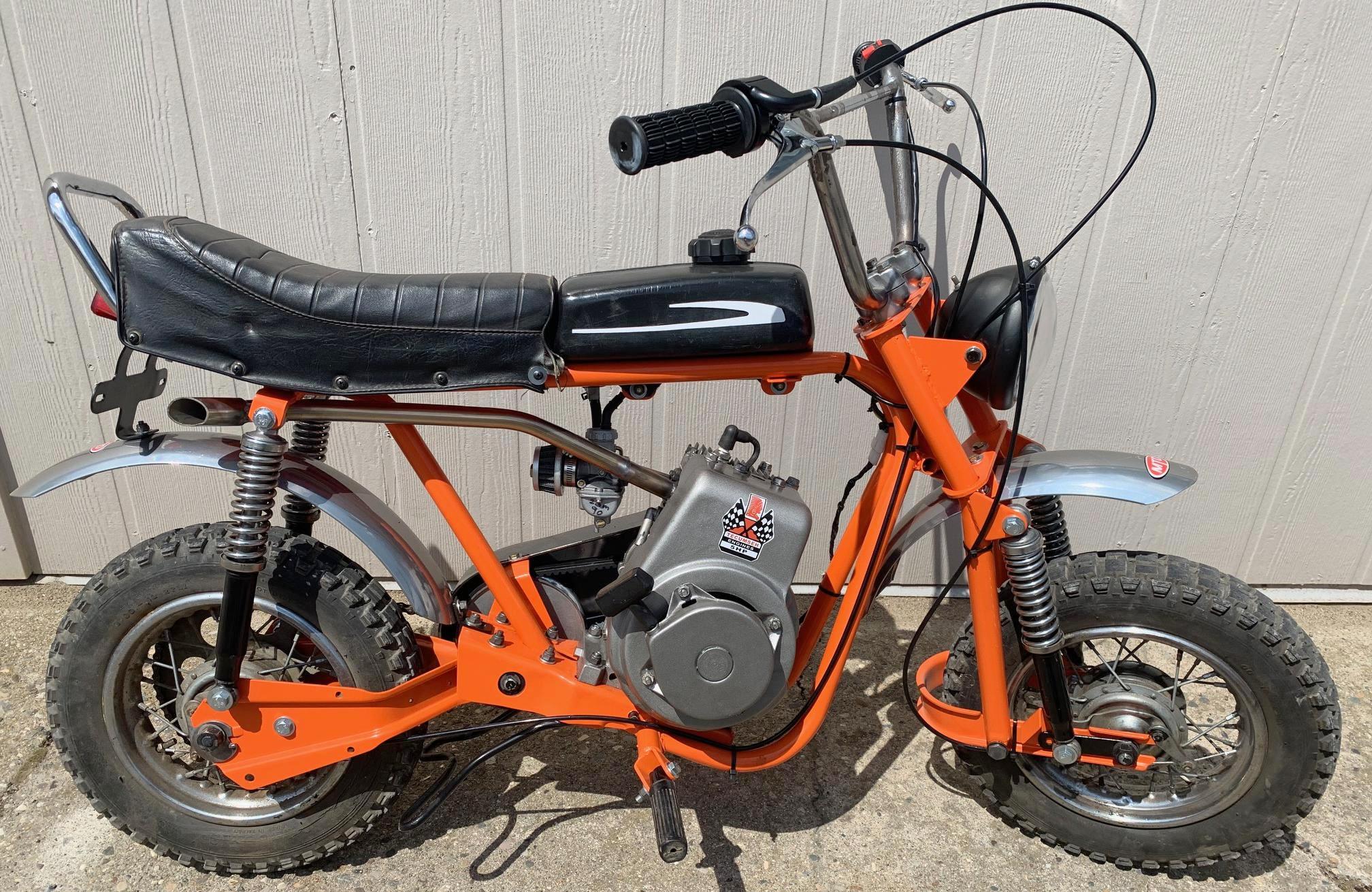
Another restored MTD/Columbia model 753 with 10" front wheel. Custom exhaust,
and the carb is a slide variety (for better performance.)
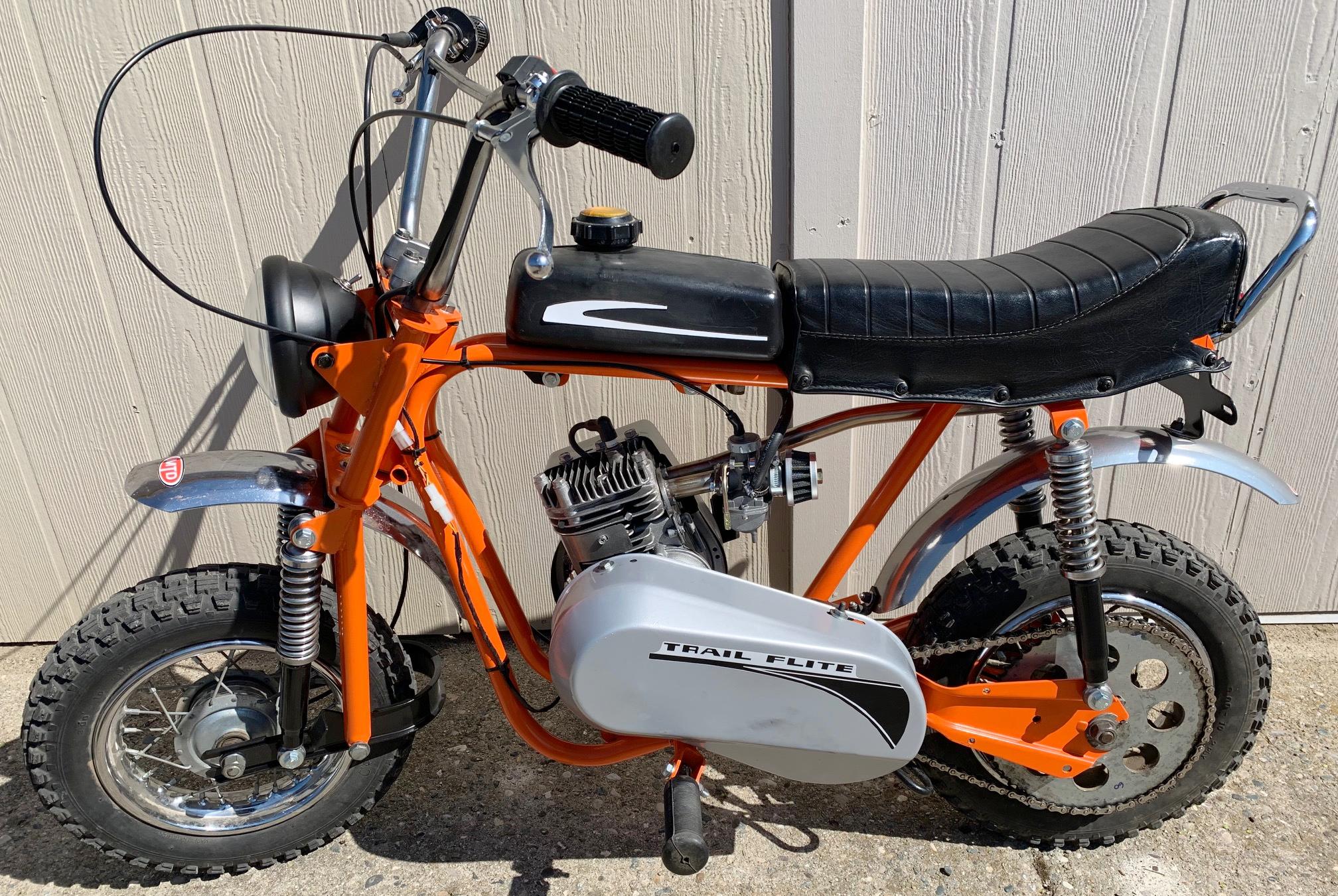
-
But at some point (figure 1974ish) MTD also fitted the 7xx models (second generation)
with a 12" front wheel and longer front swing arm (but maintained the 10" rear wheel.)
These were generally yellow and got the HS50 engines too.
This was known as the 703-2 and 753-2 models.
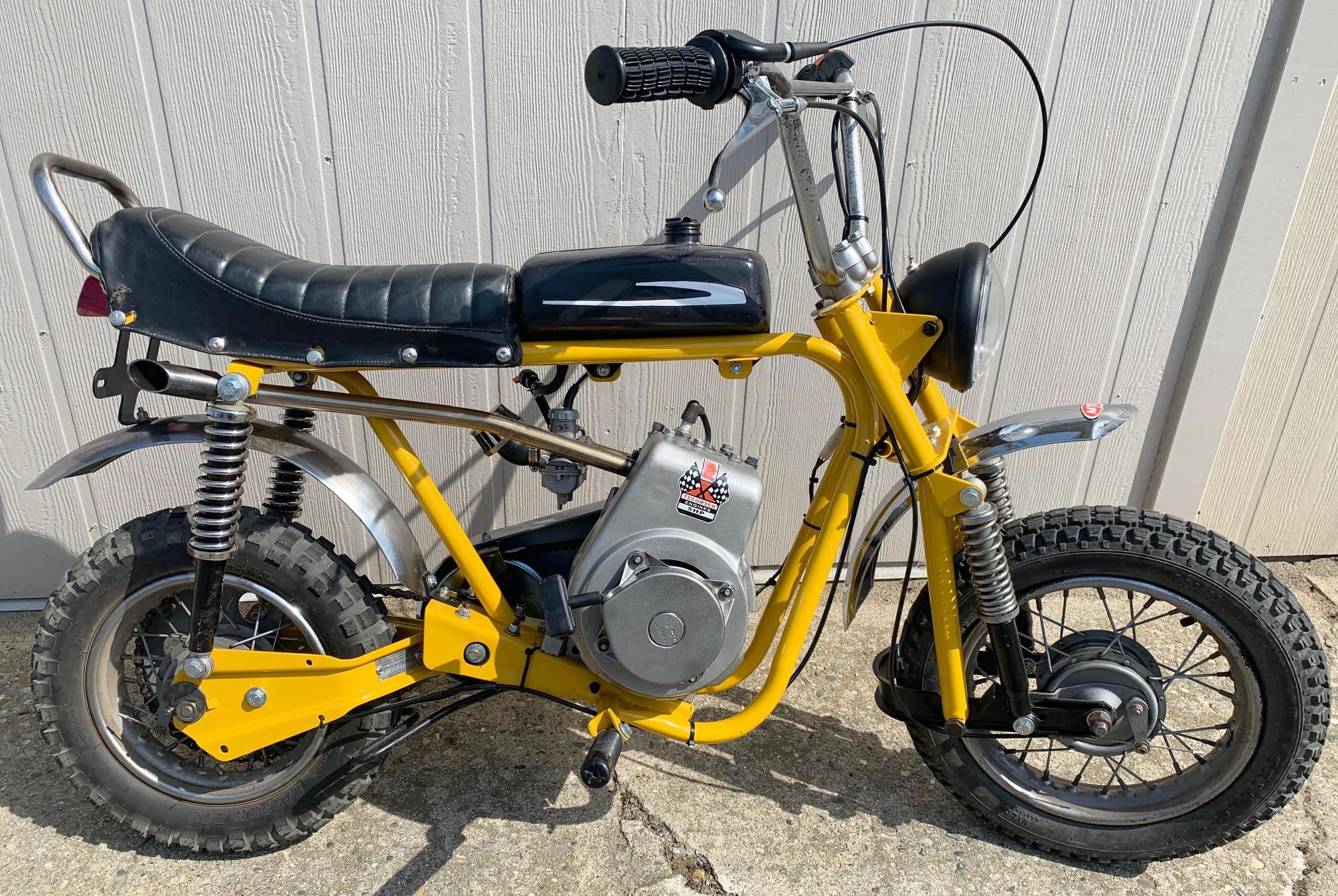
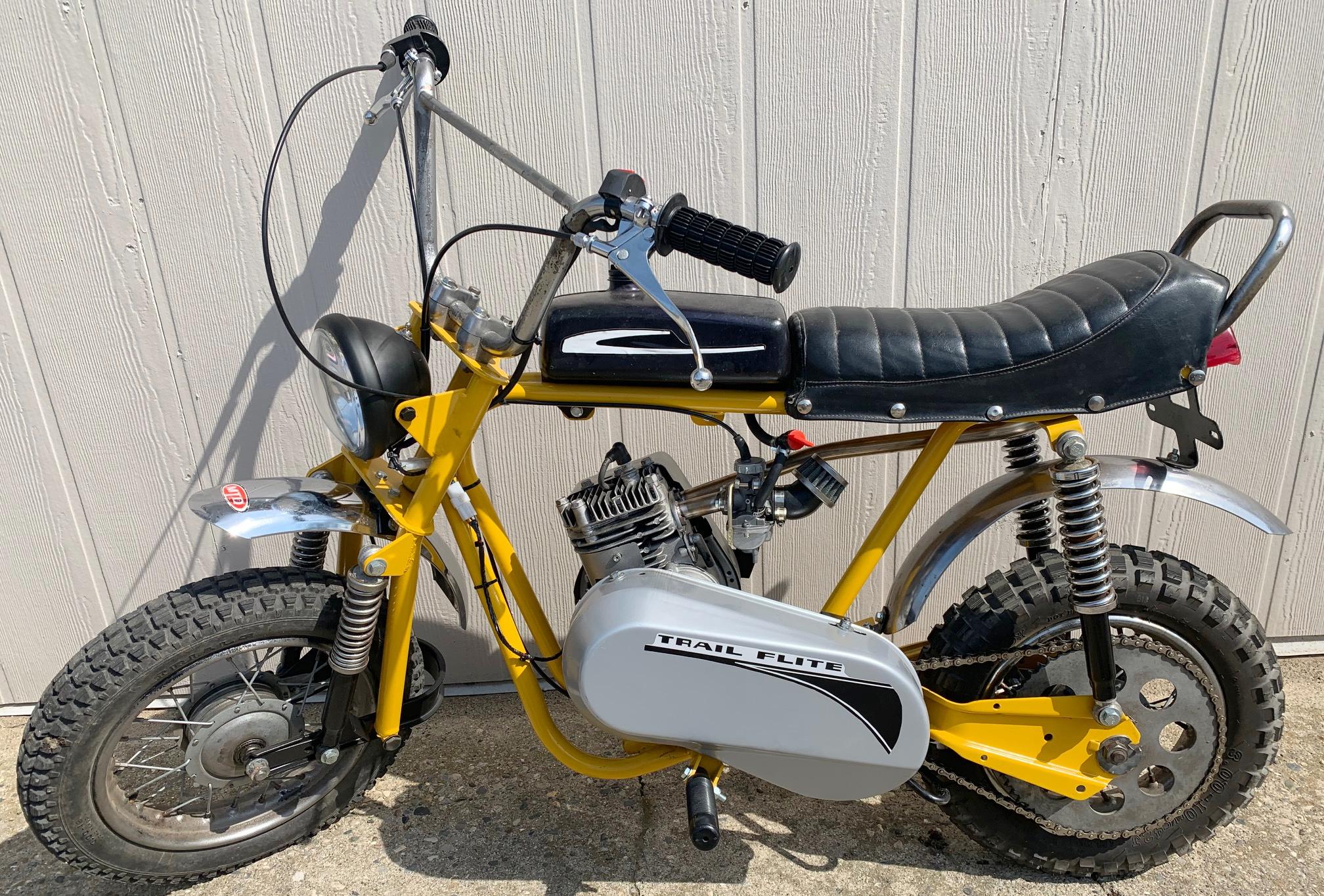
Around 1974-ish MTD came out with a copy of the Fox "Desert Fox" model with red plastic flarings (opposed to Fox's yellow flaring). This was model 368-850c and it used a two cycle Tecumseh AH817 motor and a torque converter. The motor mount was an aluminum adaptor, because the frame's motor plate was drilled for a Tecumseh footprint. Used a 16" front wheel and a 14" rear wheel.
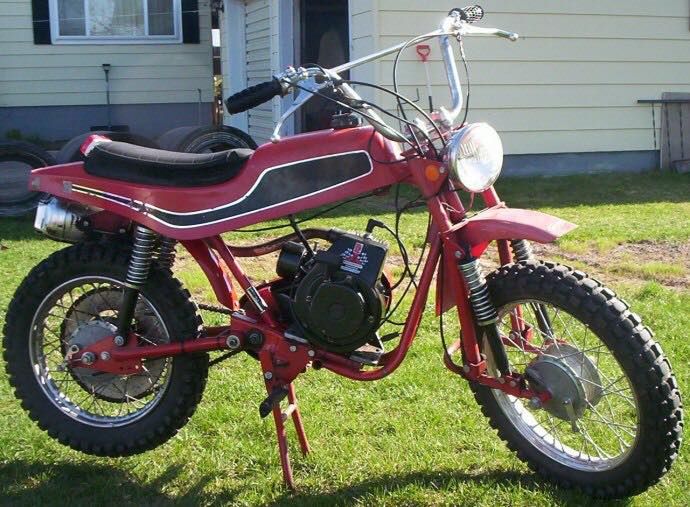
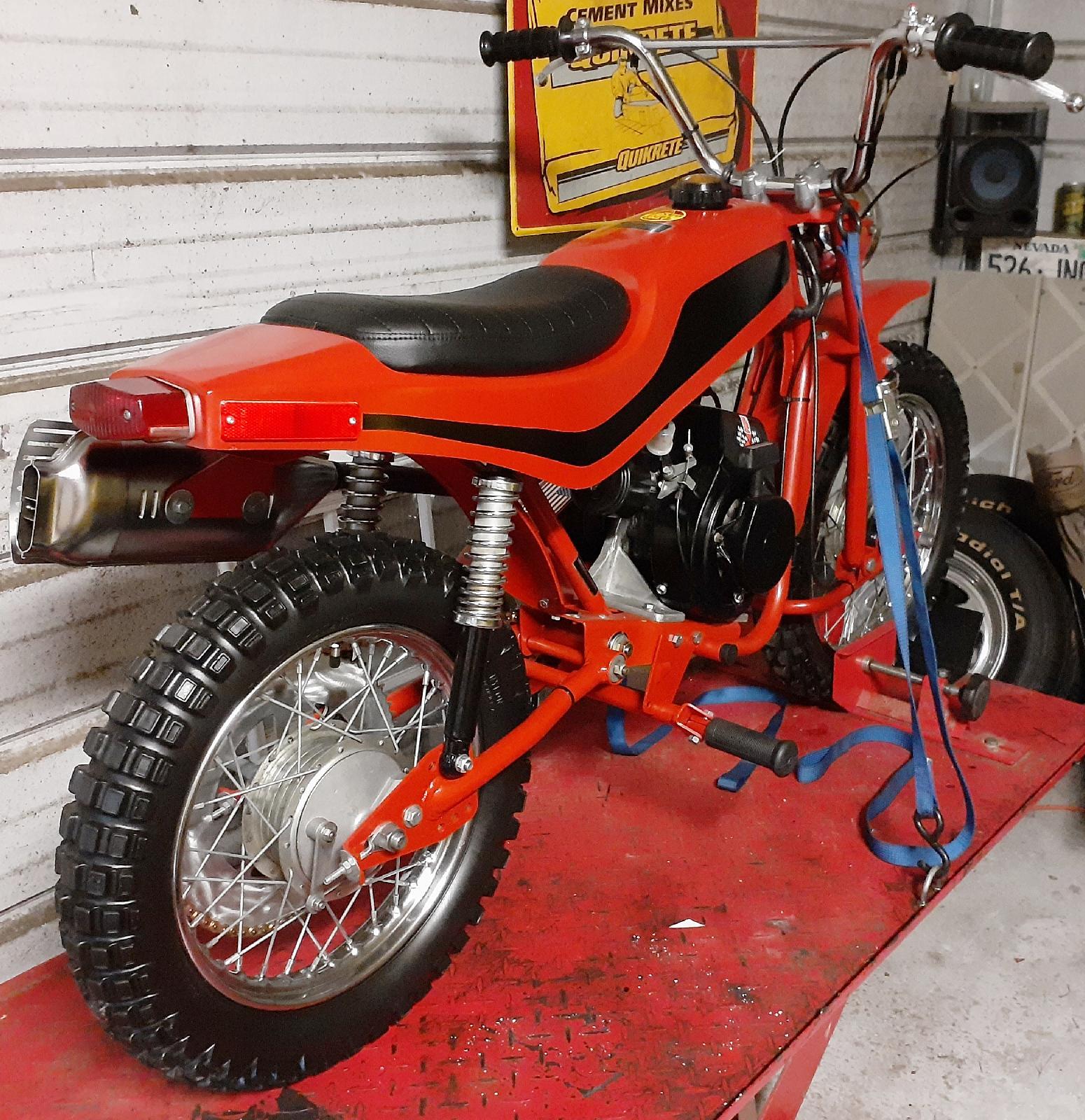
Restored model 368-850c, but the torque convert and flaring decals are not quite correct.
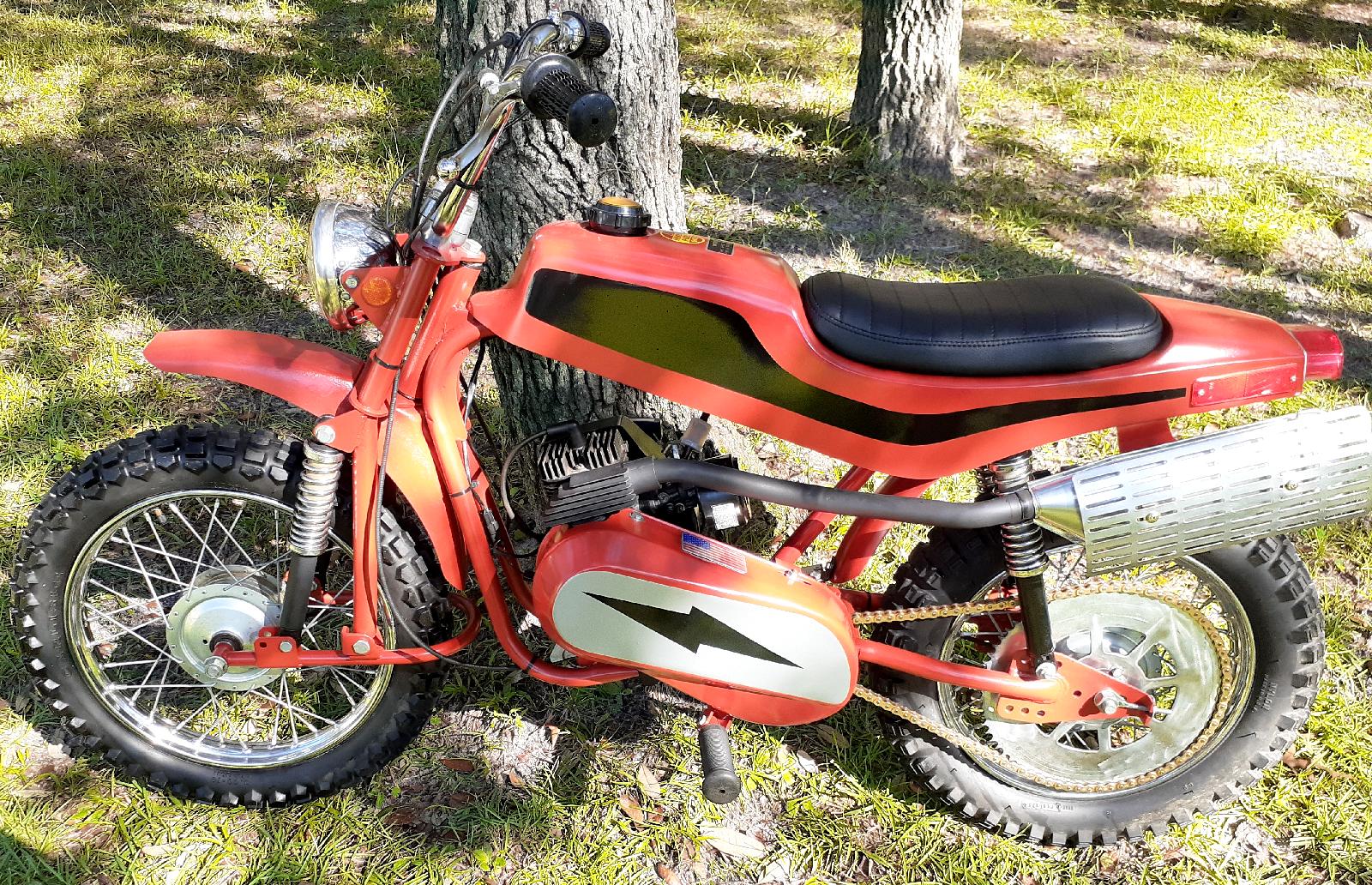
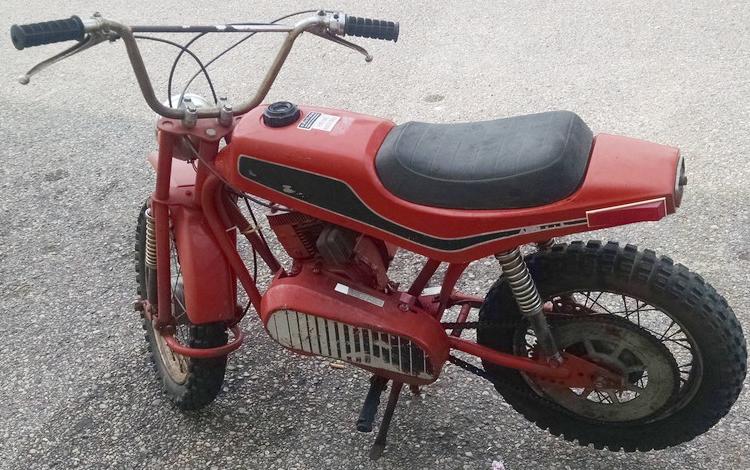
Bottom line, all the leading link MTD minibikes are really quite nice to ride. Particularly the 703-2 and 753-2 MTD mikebike models. They look a bit funky with the leading link front end, but they ride great (the motorcross style handlebars help with handling.) And with the Tecumseh HS40 or HS50 motor and torque converter, they really take off quite well! To be frank, the MTD 7xx series is one of the best vintage 1970s mini bikes made. There closest rivals were Rupp and Fox, but the MTD just rode a bit nicer with the leading link front end, and had more motor (often a 5hp, compared to 4hp on the Rupp.)
MTD Repair Issues.
-
One of the nice things about the MTD mini bikes is they use a plastic
styrene gas tank. It's nice because there's no rust issues. Not the best
looking gas tank, but fairly low maintenance.
There is however one big problem with these MTD gas tanks, and that's where the metal L gas line fitting mounts to the tank. The metal L fitting goes through a rubber tank bushing that is 33/64" in size (MTD #735-0149 or Oregon #07-392). The outside of the rubber bushing should measure 1.050" and the outside diameter of the inner section is .550". Remember NEVER use gasoline with ethanol in these tanks! Then ethanol will react with that rubber bushing, and it will most likely leak. And/or the ethanol will dry out the rubber bushing (and again, gas leaks).
Over time the rubber bushing will get hard and gas leaks will occur. Fortunately it is replaceable (MTD 735-0149 or Oregon #07-392). First pull the metal L fitting out of the bushing using channel locks. If the rubber bushing is really hard, you may have to cut the L fitting (but try not to!) Once the metal fitting is removed, the rubber bushing comes right out. A new bushing can be purchased and pushed into the bottom hole in the tank. Then the L fitting pushed through the bushing. Now your gas tank leaks should be gone. Just remember, use "recreational" gasoline with NO ethanol if you don't want to replace this bushing again!
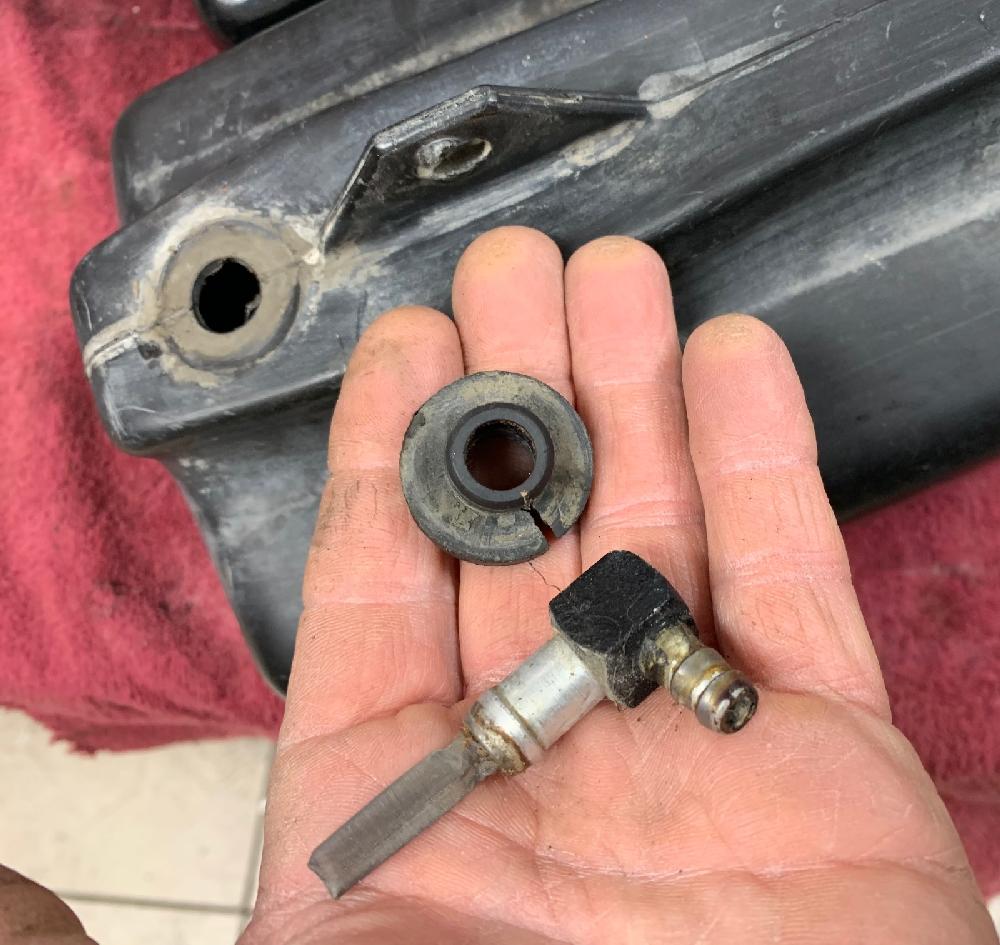
-
The torque converter on the leading link minibikes is
a Fairbank Morse asymmetrical series30 style TC. The belt used
is 5/8" wide "Cat99" belt however (belt 200397a or MTD 754-170). I highly suggest
replacing this with a Comet series30 torque converter using
a 3/4" belt (203593a).
Why do I say this? First the original Fairbank Morse system is probably worn out, being 50 years old. But the main thing is parts are hard to get. Even the belt (200397a) is not that easy to get (obsolete). Also the springs on both the drive and the driven are pretty light duty. And if you have a decent motor, they just won't do the trick. What happens is the original Fairbank Morse system switches gears too soon, and don't allow a decent motor to get into it's proper RPM band.
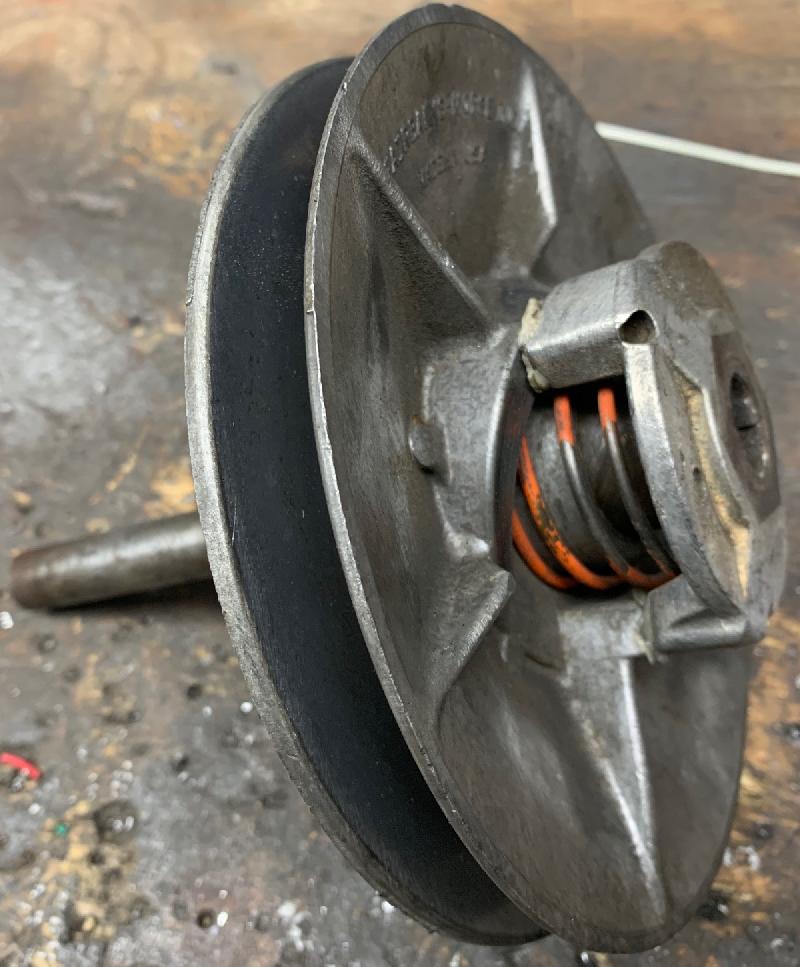
-
With the Comet series30 (or even the ebay available clones) they
are, first off, brand new. But also they are set up better for
any sort of decent motor, as they use a 3/4" wide belt. You won't be sorry you made the change.
And it's a simple bolt on modification. I highly suggest changing
to the Comet (or clone) series30 with a 3/4" wide 203593a belt.
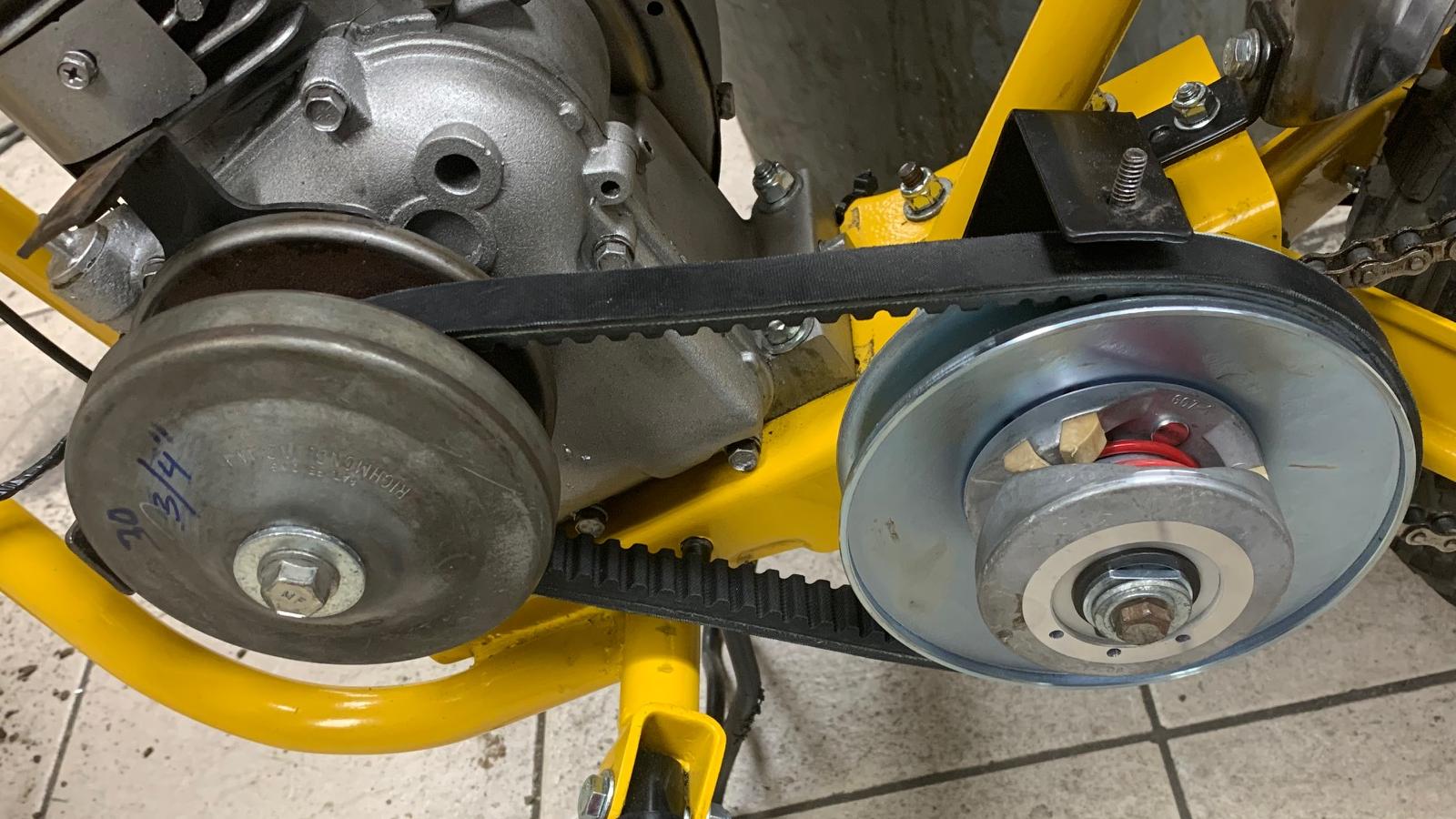
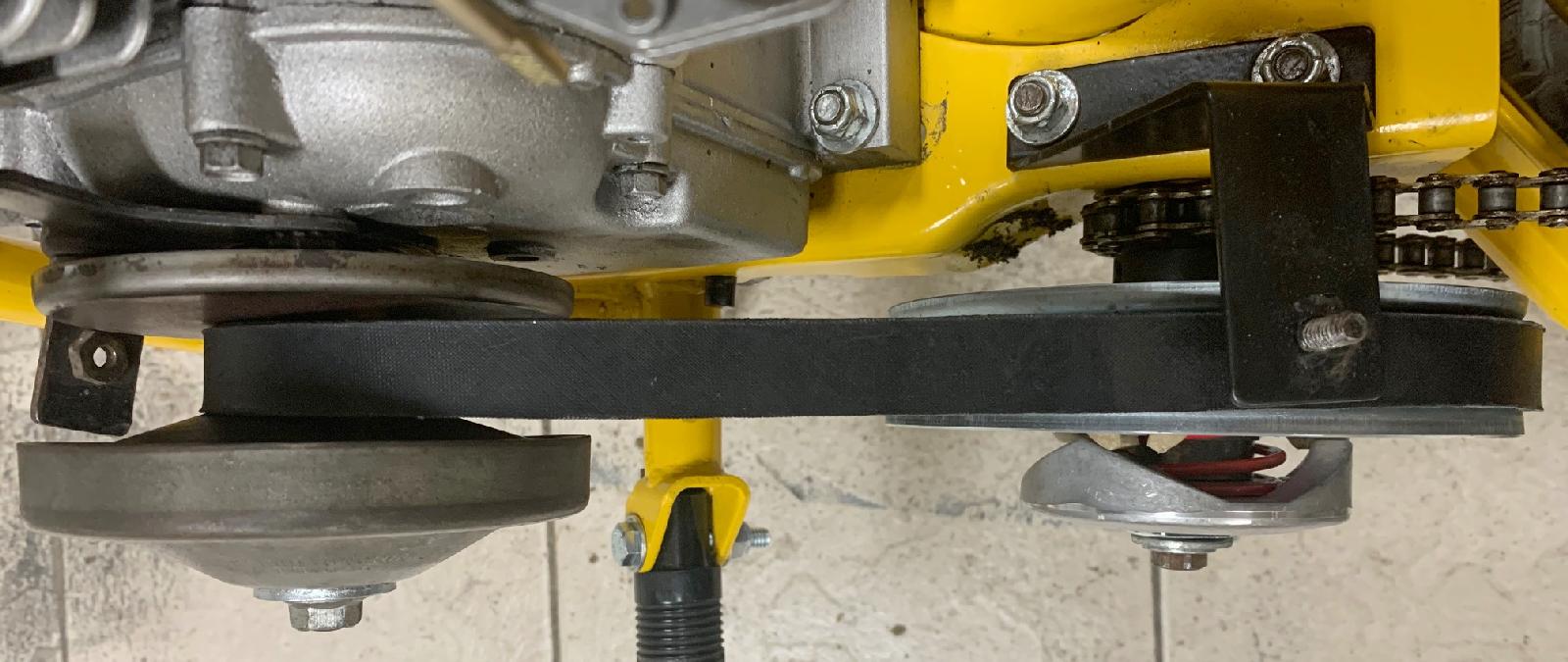
-
As for gearing, on the leading link 10" rear wheel models,
I recommend using a 11 tooth jackshaft sprocket with
the stock 54 tooth rear sprocket (4.9 to 1 ratio.) If the rear sprocket is worn out,
a 1971-1975 Rupp Roadster rear sprocket from Black Widown Motorsport will work fine
(part #17917 or #17917A.)
If you have to replace the torque converter jackshaft, you will need a 5/8" diameter keyed jackshaft about 7 3/8" long. Also it should be drilled with an H drill bit and tapped for a 5/16-24 bolt on each end. Note some people will use a 5/8-18 die on the end of the jackshaft and a nylon 5/8-18 nut. If you take that approach a longer jackshaft will be needed.
Another part that is often missing from MTD mini bikes with torque converters are the mounting brackets for the original MTD cover. There are two of these used to support the TC cover, and they mount to the Tecumseh engine side PTO cover mount holes with three 5/16-24 bolts. Because they are often missing, the bracket is available in a DXF file: MTD cover bracket DXF. With this file you can have it laser cut. I use the website sendcutsend.com to cut the DXF parts in 1/8" thickness (.125") and in stainless steel or mild steel.
The MTD torque converter bracket (two needed) that mounts to the original Tecumseh engine.
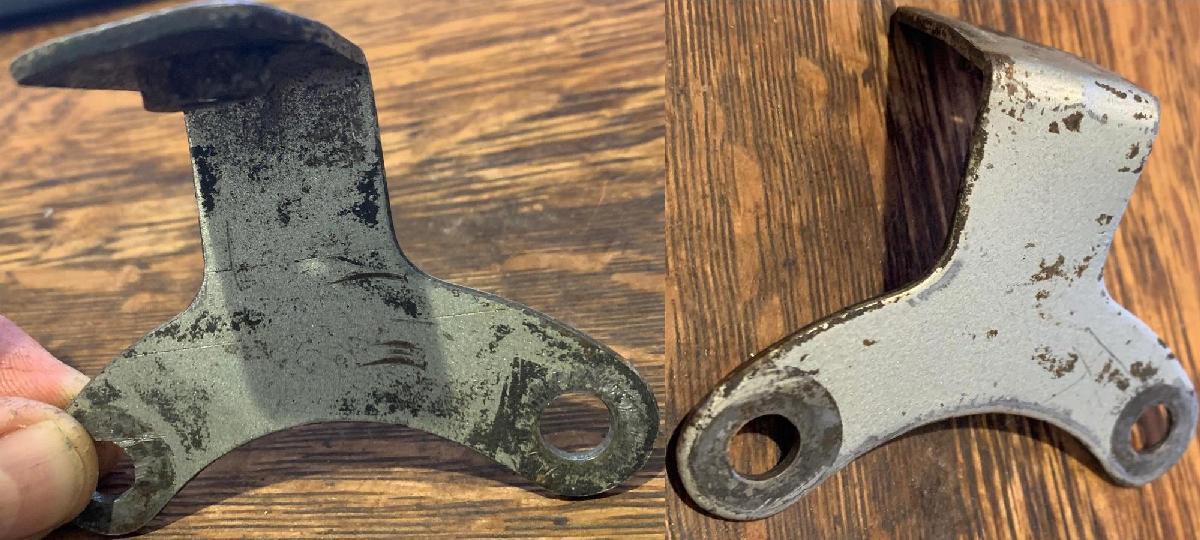
-
The Swing Arm attachment on a MTD Trail Flite is
interesting. There are two black plastic block under the motor plate,
kept in place with two U bolts.
The swing arm rotates inside the plastic blocks. This is an unusual
system, but it works quite well. However, it needs to be adjusted
correctly!

-
The key to having the swing arm work correctly is how tight the four 5/16-18 lock nuts
on the top side are tightened. If these four locknuts are too tight, the swing arm
can not move inside the black plastic blocks. Too loose, and the swing arm will
move while riding. You must have the four nuts tightened just right... not too
tight, not too loose. The best way to check this is with the rear shocks and
rear wheel removed. The swing arm should move with some resistance, but not
too much resistance.
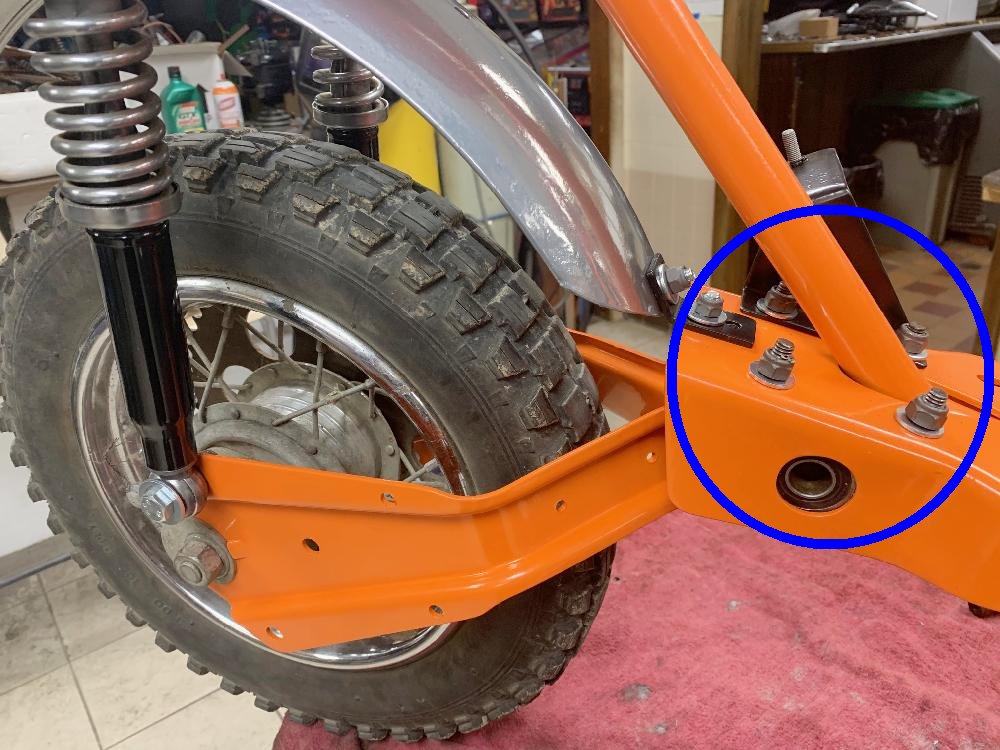
-
The rear fender on MTD Trail Flites like to break at the mounting point.
What I do is weld a washer behind the break, and TIG fill weld around the
broken area. Then grind smooth. It's an acceptable fix to this problem.
